All the things your uncle never knew about Montana’s amazing


All the things your uncle never knew about Montana’s amazing

IN THIS ISSUE:
WHAT BIRDS ARE ACTUALLY SAYING
WHY BABY ANIMALS TURN US ALL TO MUSH
HE’S IN LOVE WITH A “DEGRADED” PRAIRIE STREAM
MAY–JUNE 2023
14 At Home on Willow Creek
18 Together Again Young grizzly siblings’ high-profile journey to the Bitterroot Valley leads to an unexpected ending. By
22 Read Our Lips Contrary to what your ill-informed uncle told you years ago, suckers are remarkable fish and among Montana’s most ecologically important species. By
32 They’re Saying What? A University of Montana ornithologist explains what chickadees, buntings, and nuthatches are really communicating when they fill the forest with sound. By Sneed B.
Collard III36 Too Cute For Words Though we do need a few to explain why baby animals are so adorable.
 By Jim Pashby
By Jim Pashby
Montana Outdoors (ISSN 0027-0016) is published bimonthly by Montana Fish, Wildlife & Parks in partnership with our subscribers. Subscription rates are $15 for one year, $25 for two years, and $30 for three years. (Please add $3 per year for Canadian subscriptions. All other foreign subscriptions, airmail only, are $50 for one year.) Individual copies and back issues cost $5.50 each (includes postage). Although Montana Outdoors is copyrighted, permission to reprint articles is available by writing our office or phoning us at (406) 495-3257. All correspondence should be addressed to: Montana Outdoors, Montana Fish, Wildlife & Parks, 930 West Custer Avenue, P O. Box 200701, Helena, MT 59620-0701. Website: fwp.mt.gov/montana-outdoors. Email: montanaoutdoors@ mt.gov. ©2023, Montana Fish, Wildlife & Parks. All rights reserved. For address changes or subscription information call 800-678-6668 In Canada call 1+ 406-495-3257 Postmaster: Send address changes to Montana Outdoors, Montana Fish, Wildlife & Parks, P O. Box 200701, Helena, MT 59620-0701. Preferred
SO DANGED ADORABLE See our essay starting on page 36 to learn why people are programmed to gush over images of cute animals like these swift fox kits. Photo by Craig Miller.

COVER The bigmouth buffalo is one of nine members of the sucker family that swim in Montana. Turn to page 22 to learn about these remarkable lipped fish.
by Joel
2 LETTERS
3 TASTING MONTANA
4 OUR POINT OF VIEW
5 FWP AT WORK
Ark.
The “chicken” that chuckles I loved your article on common fish and wildlife names and nicknames (“What’s That Animal Called?” March-April 2023). I got a good laugh at a few I’d never heard before. You’re missing my favorite nickname of all, and that’s the nickname for sharp-tailed grouse as “chuckle chicken” as it blasts across the prairie with its unmistakable call.
Russell Schmidt Belgrade Editor replies:We received an overwhelming response to our name article, including these additional nicknames: “teeterbutt” (American dipper), “gopher” (various ground squirrel species), “hammer handles” (small northern pike), “beggar tick” (houndstongue), “rattler” (prairie rattlesnake), and “groundhog” for marmots.
To introduce more people to the story, Nick Danielson, FWP’s social media coordinator, devised a game (graphic below) on Instagram to put users’ nickname knowledge to the test. Each Thursday in March, he posted nicknames of Montana wildlife, fish, and other critters along with four possible correct common names.

“We ended up with between 1,500 and 2,000 participants each week, and out of those we had a lot of traffic to the article itself (which is posted on the Montana Outdoors website),” Danielson says.
For years our family spent a lot of time separating out the meat on venison shanks for a small amount of trim for sausage or burger. Then, a few years ago, we discovered one of the Montana Outdoors recipes for shanks and could kick ourselves for all the shanks we wasted over the years. We love venison, and the shanks may be the best meat on the deer. Thank you.
Ron Brey BozemanEditor replies: For more recipes featuring braised venison shanks and other tough cuts, visit the recipe page on the Montana Outdoors website at fwp.mt.gov/montana-outdoors and then scroll down the page to the “Tasting Montana” section.
I couldn’t agree more with your wonderful essay, “The dog days of autumn” (Sketchbook, November-December 2022). I grew up with my
FWP’s Instagram page featured a game based on the “What’s That Animal Called?” article.
dad’s Labs in our family but never fully recognized their importance until I started hunting upland birds, first in North Dakota and now on annual trips to Montana.
The fact that your agency (and kindred federal offices) make myriad public and private walk-in lands available to upland hunters is why we keep coming back. Our pack of pooches (in truth, more house pets than field trial gems) has grown to two Brittanies and two Labs, largely because of the efforts FWP has made to accommodate upland bird hunters. And, at 68, I’ve finally learned to appreciate just how much those girls (no boys in our canine crew) mean to me.
Your piece hit it right on the head: Without dogs, there’d be far less magic to our waterfowl and upland hunts. Thanks for all your agency does to welcome out-of-state interlopers and their four-legged friends.
Judge Mark Munger (Retired) Duluth, MNI just read the essay “The Freeze Baby” (Sketchbook, March-April 2023). Like you, I suffered for years from cold hands. I’ve probably bought more gloves than your local sporting goods store has in stock, and I couldn’t even guess how many of those “hand
warmers” I’ve purchased over the years. Nothing worked.
Then in 2022, just after big game season closed, I went in for my annual physical and mentioned to my doctor, who’s an avid outdoorsman, the problems I was having with cold hands. No sooner had I commented when he mentioned nifedipine.
What a game changer! This past hunting season, I was able to use my phone for OnX maps and photos with no gloves at all, and then could hunt in lightweight gloves that allowed me to actually feel the trigger. An added plus is that I can use the drug just on the days when I’m hunting or otherwise recreating outdoors.
Andy Kvasnak EurekaEditor replies: According to the Mayo Clinic website, nifedipine is used to treat a condition known as Raynaud’s (ray-NOSE) syndrome. The disease “causes some areas of the body—such as fingers and toes—to feel numb and cold in response to cold temperatures or stress. In Raynaud’s syndrome, smaller arteries that supply blood to the skin narrow. This limits blood flow to affected areas, which is called vasospasm.”

Treatment for Raynaud’s can include calcium channel blockers, which relax and open small blood vessels in the hands and feet. “Examples include nifedipine (Procardia), amlodipine (Norvasc), felodipine, and isradipine,” the Mayo site says.
Be sure to see your doctor for diagnosis and testing before taking any new medication. n
We welcome all your comments, questions, and letters to the editor. We edit letters to meet our needs for accuracy, style, and length. Write to us at Montana Outdoors, P.O. Box 200701, Helena, MT 59620-0701. Or email us at: tdickson@mt.gov.

2 lbs. pheasant tenders or breast meat cut into 1-inch-wide strips. Or substitute venison loin or chicken.
2 c. vegetable or canola oil

2 eggs, beaten lightly
1 t. water
½ c. flour, seasoned with salt and pepper
1 c. panko bread crumbs
1 c. mayonnaise
1-2 T. sriracha sauce
1 T. fresh lime juice
1 large garlic clove, crushed or finely grated Pinch kosher salt
In a deep cast-iron skillet or Dutch oven, heat oil over medium heat to 350 degrees F. Meanwhile, de-tendon the tenders (see instructions at left). Pat dry.
Put flour in a shallow plate. Beat water and egg with a fork in another shallow plate. Put panko in a third plate.
Now that the Longest Winter—or so it seemed to me—is over, people are emerging from their homes. We’re all pale and dazed, glancing about to see if anyone else came out alive. Mostly they did, and what better way to celebrate our collective survival than with a backyard party.
There’s an endless list of fancy, delicious main dish, appetizer, or dessert recipes online, but the most popular one I make is a plate of crispy brown breaded pheasant strips with sriracha aioli dip.

I use pheasant or blue grouse “tenders,” though regular breast meat cut into strips works fine. The tender, or tenderloin, is an independent secondary muscle that lies directly under the breast. Running down the center of the tender is a long, pale, narrow tendon that looks like a flat egg noodle. Though the tendon is edible, it gets a bit rubbery when cooked. I remove mine by grabbing the end with a paper towel and pulling it through the tines of a fork that holds the tender stationary.
Aioli (ae-OH-lee) is mayonnaise seasoned with crushed garlic. I add a little sriracha sauce (found in the Asian food aisle) and lime juice to jazz it up.
This simple appetizer also works with thin strips of venison loin or chicken (de-tendon the tenders the same way as described above). n
When the oil reaches temperature, dip tenders in flour, then egg-water mixture, then panko, pressing the bread crumbs firmly with your fingers.
Place in the hot oil, being careful not to splash. Turn up the heat slightly, as the oil will cool with the addition of the tenders. Cook 4–6 minutes, until underside is light brown. Flip with a fork and continue cooking until browned on both sides.
Remove with slotted spoon or spatula and set on wire racks over paper towels. Salt liberally. Best served when hot or warm.
Add mayo, 1 T. sriracha, lime juice, and garlic to a medium bowl, whisking to combine. Season to taste with kosher salt. If it’s not spicy enough, whisk in the second tablespoon of sriracha. Refrigerate up to two weeks. Serve at room temperature.
If you have to transport or delay serving, reheat the fingers in a toaster oven at 350 degrees F. for five minutes. You can heat them in a microwave on high for 30 seconds, but any longer and the breading turns soggy. n
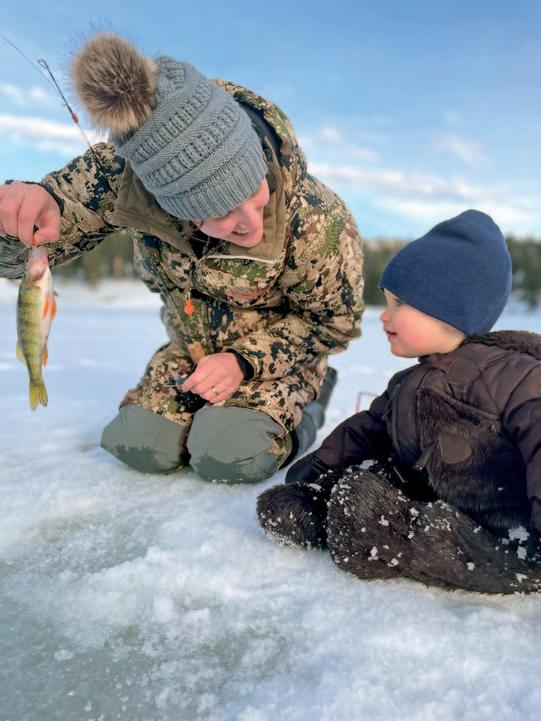
When I was in grade school, there was a local pond nearby that my friends and I could ride our bikes to and fish. It wasn’t much of a pond (mostly bullheads), but we had fun watching our red-and-white bobbers go under once in a while and just messing around along the shoreline. We dug for worms, turned over rocks, watched gulls and turtles—the fun but unremarkable things kids do when they’re allowed to spend time in nature.
By the time I was in junior high school, our family had moved to a small piece of land in the country. In summer, I’d cut hay all day at the neighbor’s place with their kids, and then afterward we’d all go fishing. Three or four of us—and sometimes my dad, too—would pile into a 16-foot aluminum boat with a little 3½-horsepower motor and cross a nearby lake to fish for perch and sunfish. We also had a little trout stream on our land, where my buddies and I could fish when it wasn’t too muddy.
The access I had to fishing waters when I was young is what got me hooked on fishing and then other types of outdoor recreation. That’s also true for many FWP employees and other people I talk to while traveling around Montana. We know that, as was the case for us, if kids have accessible places to fish, they will more likely get turned on to the joy of spending time in the natural world, and then work to conserve that world.
That is definitely something this department is committed to making happen.
For instance, FWP’s Community Fishing Pond Program funds and supports community efforts to create or improve easy-access ponds where kids have a good chance of catching stocked fish. The 65 waters, like Pine Grove Family Fishing Pond outside Kalispell, are mostly west of the Divide, near Montana’s population centers, but a few are in north-central and eastern parts of the state, like Home Run Pond in Glasgow. (Find the ponds on our website at fwp.mt.gov.)
In FWP’s two eastern regions (Region 6, the northeast, and Region 7, the southeast), we stock another 200 fishing ponds that have public access. (Call our regional offices for guides showing loca-
tions and fish species available for each pond.)
All these pond fishing opportunities were developed with kids and families in mind. The community members, rod and gun clubs, and FWP staff who maintain and stock these waters know what it’s like to see the look on a girl’s or boy’s face as they reel in their first 10-inch rainbow trout or largemouth bass. It’s magical.
And that’s just the ponds. FWP also owns and manages more than 330 fishing access sites on streams and rivers statewide. Many provide family-accessible shore fishing opportunities. (They too can be found on the department’s website.)
Our department also helps kids learn about fish and angling through our Hooked on Fishing Program. Each year in 200 classrooms across the state, Montana students learn how to dissect a fish, cast a spinning rod, tie on lures, and figure out where fish are most likely to be found on a pond or stream.
This department is here for several reasons, and a major one is to make it as easy as possible for people—young and old—to connect with the outdoors. That’s the thinking that went into the FWP tagline: The Outside Is In Us All.
If we want our kids and grandkids to care about a healthy environment, we need to give them reasons to care, and that starts with taking them outside to enjoy and value outdoor recreation. FWP offers a ton of fishing opportunities, especially for youngsters and beginners, and I urge everyone to take advantage of what we have in this state.
The great outdoors is definitely in most Montana families, like that of my wildlife conservation colleague, Kevin Farron, regional policy manager for Backcountry Hunters & Anglers, who took the photo at left this past winter of his wife, Laura, and daughter, Hadley, ice fishing on Salmon Lake.
It’s in my family, too. I’m looking forward to taking my 11-yearold grandson, Gabe, and 10-year-old granddaughter, Dillynn, fishing as much as possible this summer. Maybe you’ll see us out there. Look for a boy, a girl, and their grandpa, each with a big grin on their face.
Hank Worsech, Director, Montana Fish, Wildlife & ParksI GREW UP IN CASCADE, a small town about 20 miles southwest of Great Falls. Back then I had no idea there were careers with Montana Fish, Wildlife & Parks other than being a game warden. But when I was a junior in high school, a fisheries biologist helped me with a science project that looked at concentrations of heavy metals in fish and ospreys. The project got me into an international competition and was even published in a book.
From that initial FWP contact, I ended up working for the department in Missoula while I went to the University of Montana to get my degree in fisheries science, and then at various positions in Great Falls, Miles City, and now in Helena, where I’ve been a creel clerk for the past few years.
My job is to interview anglers at fishing access sites on Canyon Ferry Reservoir from early January to late October. I ask them what they were fishing for, what they caught, and what baits or lures they used. If they harvest anything, I also measure their fish. Biologists use that information along with our annual gill net surveys to get a
picture of the fish population each year and decide if FWP needs to adjust harvest regulations or trout-stocking levels. The Canyon Ferry survey is one of Montana’s longest continuous-running creels, dating back to the 1980s, so it’s rewarding to be part of that history.
I love this work because I love talking to anglers. I get to meet so many interesting people from Montana, other states, and even other countries. People are almost always positive, and I’ve learned a ton about fishing— especially for walleye.
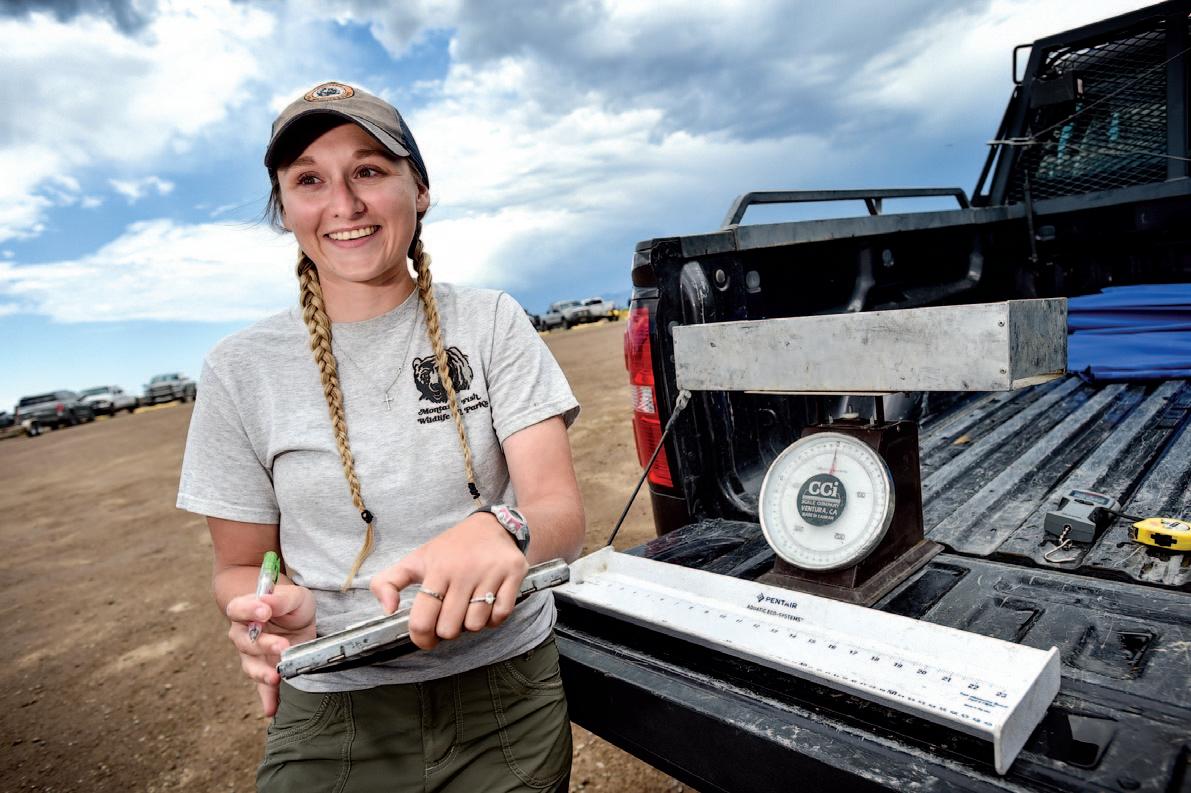
I also love working for FWP in general. The people I’ve worked with have always been very team-oriented and supportive. And I get to do a wide range of work throughout the year, including helping with a new FWP kids’ fishing web page.
Being part of fishing education is especially significant to me because I had an older brother who was a teacher. He died following complications from a car accident, and part of my motivation to serve the public and help teach others is to honor his memory.
“TELL ME YOUR FISH STORY.”
closest to the photographer. “I took about 30 shots of that mayfly sitting there, and it just so happened that one of the shots caught it as it was flying off, because there’s no way I could have timed that intentionally.” n
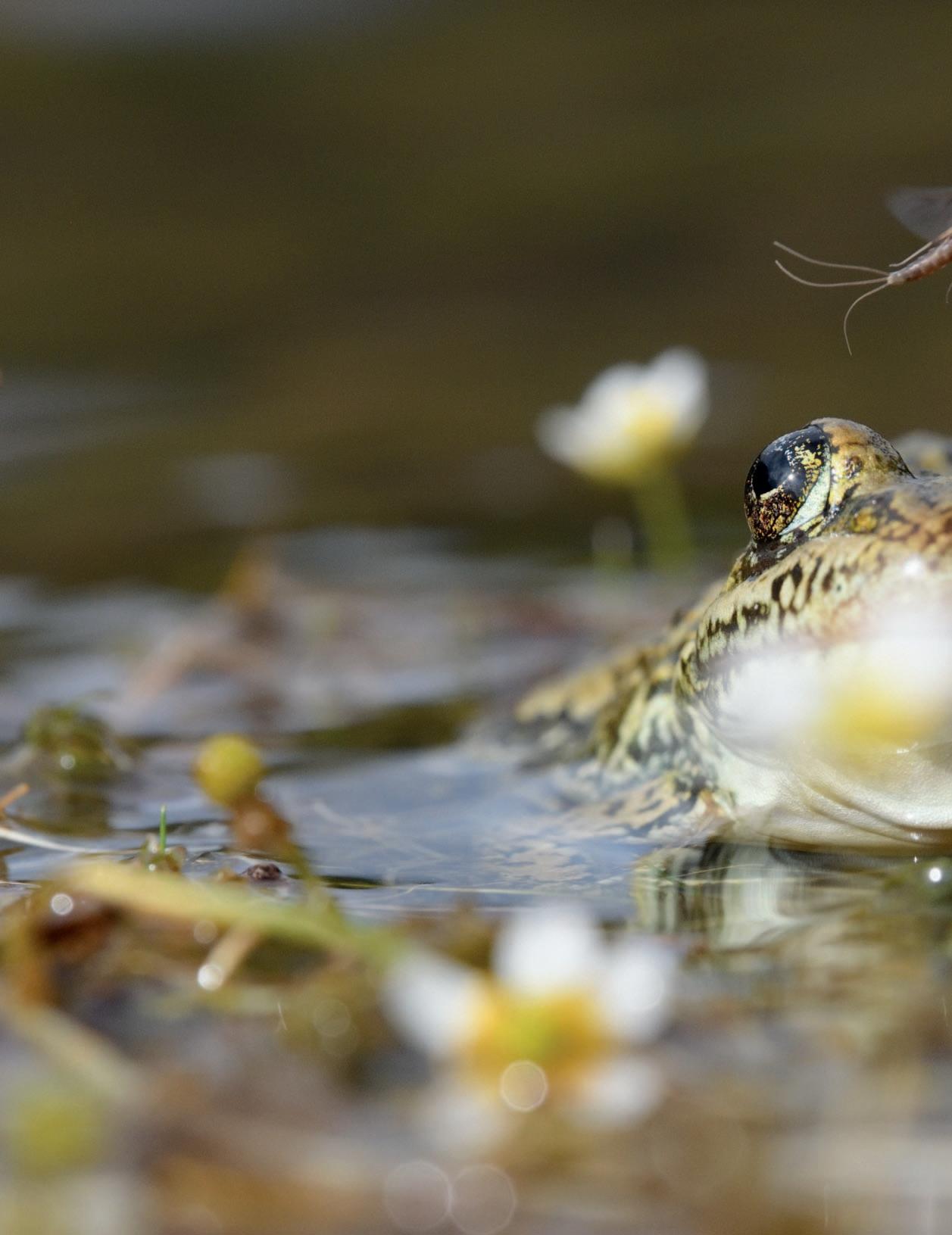

Dee Linnell Blank, of Whitefish, was hiking last May along Lubec Ridge in the Badger-Two Medicine area, just south of Glacier National Park, when she spotted these clumps of mountain douglasia nestled in the shelter of a downed limber pine snag. “I’m enchanted by how cushion plants tuck into logs or rocks in open exposed areas,” Blank says. “These particular clumps caught my eye because the snag had that wonderful texture and sinuous shape caused by the wind blasting up there. The addition of the bright fuchsia color of the douglasia and the chartreuse of the wolf lichen made the image that much more spectacular.” n


Attention wade anglers: You might be transporting aquatic invasive species (AIS) on your boots or waders when moving from one river or lake to another.
Each year FWP checks thousands of boats, kayaks, and other watercraft at mandatory AIS check stations. But wade anglers aren’t required to submit their gear for inspection. “That means it’s up to wade anglers themselves to clean, drain, and dry their boots and waders before fishing someplace else,” says Tom Woolf, chief of the FWP AIS Bureau.
Woolf notes that invasive mussel larvae, fragments of Eurasian watermilfoil, and fish pathogens can lodge in wader and boot crevices. “Get in there with a brush and clean out all the mud and vegetation you can find,” he says. n
No one knows why elk numbers in the lower Clark Fork River area have declined over the past two decades. Some think it’s due to the growing number of wolves, which add to existing predation by black bears and mountain lions. But the cause could instead be elk habitat declines, disease, weather, or some combination of these factors.
Dr. Kelly Proffitt aims to find out.

Proffitt, an FWP senior research scientist, is leading a multi-year study that kicked off this past winter with the capture of 62 elk in Hunting District 121. The heavily forested district extends northwest of Thompson Falls on either side of the Clark Fork River through the Lolo and Kootenai national forests to the Idaho border. “Our goal is to figure out what is influencing the elk populations there,” she says.

Proffit, other FWP wildlife biologists, and researchers at the University of Montana W.A. Franke College of Forestry and Conservation aim to learn about pregnancy, recruitment, and survival rates;
how elk interact with wolves, bears, and lions;
where elk move throughout the year on public and private land;
the types of habitats elk need most; and
how land-use practices such as logging could be adjusted to benefit elk.
“The idea is to better understand elk popu-

lation dynamics by studying top-down influences like predation and bottom-up influences like habitat,” Proffitt says.
Neil Anderson, FWP regional wildlife manager in Kalispell, says the information Proffitt and her team gather will be used to develop more effective elk hunting regulations, improve habitat, and take other management actions. “It will also help us collaborate with the U.S. Forest Service on forestry practices that benefit elk and other wildlife,” he says.
From December through February this past winter, crews captured and GPScollared 47 adult females, 7 adult males, and 8 calves. Cow elk were also fitted with implants that detect when and where calves are born so biologists can also capture and collar the young animals and then track survival and mortality rates.
Crews also captured and collared three female mountain lions in the study area. The lions were fitted with satellite-linked GPS collars that record locations every four hours for three years. Researchers also hope to capture seven additional mountain lions, ten black bears, and five wolves to monitor their locations. “This will help us evaluate large carnivore population numbers and identify different causes of elk mortalities,” Proffitt says.
Follow the Clark Fork elk project’s progress at fwp.mt.gov/aboutfwp/regions/region1. n
With the help of conservation groups and real estate professionals, FWP recently purchased two Yellowstone River island parcels upstream of the existing Indian Fort Fishing Access Site (FAS) near Reed Point, halfway between Bozeman and Billings. The parcels, totaling 107 acres, will remain undeveloped to provide wildlife habitat and rustic recreation such as fishing, camping, and bird watching while retaining the river’s wild character.
“The islands are in a reach of the Yellowstone that we consider high priority for additional public access,” says Mike Ruggles, FWP regional supervisor in Billings.
The department purchased the land using state natural resource restoration settlement funds from the state’s successful lawsuit against ExxonMobil over the company’s 2011 oil spill into the Yellowstone River. The funds are administered by the Montana Natural Resource Damage Program (NRDP).
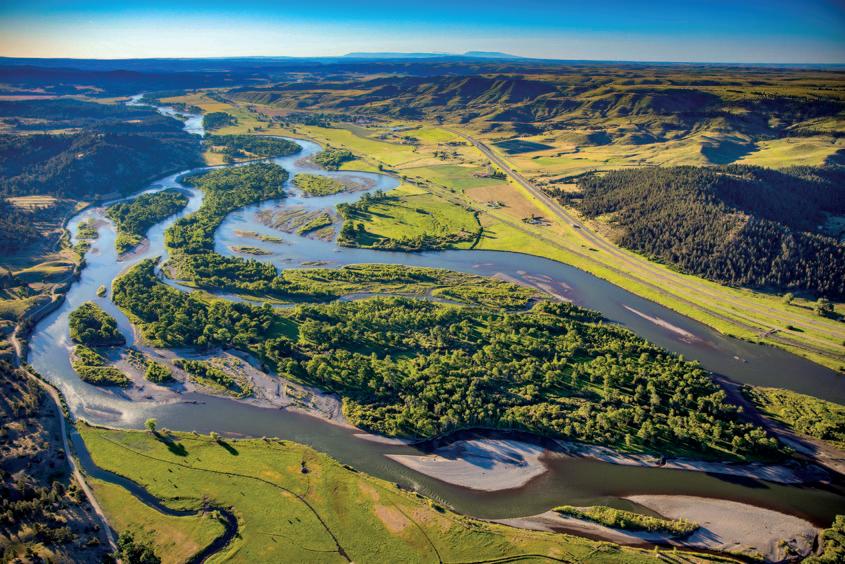
To prevent the parcels being sold to private developers before the state could act on a purchase, the conservation real estate firm Beartooth Group, working with Trout Unlimited and Montana Freshwater Partners, first bought the properties and later sold them to the state. “Through partnerships across like-minded conservation groups and working closely with state agencies, we were able to ensure the protection of this critical habitat for wildlife along with new public
Anglers new to Montana and even longtime residents are always looking for accessible places to fish for trout, walleye, and other popular species. The most convenient spots are FWP fishing access sites (FAS). The department manages more than 330 of these sites on streams, rivers, reservoirs, and lakes across the state.
Fishing access sites often feature boat ramps and usually provide shore fishing opportunities. Find the sites on the FISHMT
access,” says Robert Keith, Beartooth Group founder and managing principal.
The public now has full access to the properties.
The new acquisitions enlarge the Indian Fort FAS and add to a system of other nearby access areas, including Bratten FAS, 4 miles upstream, and Cottonwood Island FAS,
6 miles downstream, purchased in 2021 from the Montana Department of Transportation using NRDP funds. “Left undeveloped, these acquisitions provide public access to primitive recreational opportunities, maintain natural river function, and preserve aquatic and terrestrial habitats,” says Ruggles. n
Q. When I clean a fish, can I toss the entrails in the water?
app, available for Apple or Android products. Or visit the FWP website homepage, click on FISH, then EXPLORE.
The app brings up a state map where you can zoom in to see FAS locations, indicated by a brown fish with a brown border. Click on an icon and FISHMT shows a photo of the site and contact information, directions, restrictions, fish species available, stocking records (if the water is stocked), and camping and other recreational opportunities. n
A. Yes, but it’s best to clean the fish on shore and then take the entrails in a boat out to sink in deep water so they don’t wash up and stink up the shoreline. Note that you must keep the head, skin, fins, and tail attached to all harvested fish so a game warden can identify and count the species. Never leave entrails in or around a campsite or on the shoreline.


Naturalist blogger Shane Slater talks about why porcupines have become rare in western Montana, after decades of being so numerous they were considered pests.

A new way for adults and kids to learn about basic fish biology. The fun online activity shows where fish organs are located and what they do. It’s like a real fish dissection without the mess.
FWP’s Corie Bowditch and Matt Ferrell of the U.S. Forest Service help Woodsy Owl investigate parks, forests, and even an urban backyard to find just the right place to live in the Helena Valley.

Golden eagles look a lot like immature bald eagles, especially because “baldies” don’t get their white head feathers until age four or five. But if you look closely, especially from below when the birds are flying, the differences are clear. n




What they are
Two invasive mussel species threaten Montana waters: zebra and quagga. These small freshwater mollusks have been steadily moving west since arriving in the Great Lakes from Europe in the ballast water of oceangoing ships during the 1980s.
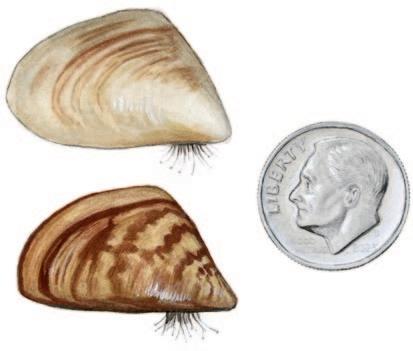
How to spot them
The D-shaped mussels are ¼ inch to 1 ½ inches long and have brown or dark brown striped shells. They attach to rocks, boat docks, and boat engines in the water of lakes and rivers and can completely blanket these hard surfaces.
Where they are found
Currently, there are no known infestations in Montana. But each year, dozens of boats traveling through Montana from other states have been found, at mandatory FWP check stations, to be carrying invasive mussels.
Why we hate them
Invasive mussels reproduce like crazy, rapidly producing local populations in the billions. The filter feeders consume microscopic plants and animals, robbing food
A quick look at a concept or term commonly used in fisheries, wildlife, or state parks management.
It may seem obvious, but streams need a healthy water flow to support trout and other fish. Unfortunately, hundreds of streams across Montana lack adequate “instream flow” (water moving through their channels).
Many trout in Montana’s premier rivers like the Madison, Big Hole, and Gallatin spawn not in the main channel but in tributary streams. Adult trout need enough water to reach upstream spawning areas. After hatching, baby trout need a certain amount of water to survive the next several months. Then, as young trout, they need adequate water to swim downstream to the main river, where in a few years they grow to catchable size.
Yet portions of more than 300 streams across Montana, many of them trout spawning tributaries, drop dangerously low or even dry up each summer. Baby trout are trapped in the shallow pools, where they die outright or become easy prey for birds.
The main causes are inadequate snowpack, natural leakage into gravel substrate, diversions for municipal water supplies, and, especially, diversions for crop irrigation.
To provide roughly 60 previously dewatered streams with adequate instream flow, especially in late summer, FWP and groups like

from native clams, underwater insects, and baby fish. When the mussels die and wash up on shore, they stink up beaches and cover sandy areas in sharp shells. Invasive mussels also clog and damage irrigation pipes and intake valves and can ruin boat and factory motors.
How they spread
Invasive mussels and their microscopic larvae, known as veligers, survive in water or wet areas of boats, engines, wading boots, and other fishing gear. When these items are moved from infested waters to other reservoirs, lakes, or rivers, they can transport the invasive mussels.
Clean, drain, and dry watercraft and irrigation equipment before use in other water bodies. Thoroughly wash and decontaminate fishing gear, waders, and boots.
Report any suspected infestations at nas.er.usgs.gov/SightingReport.
Trout Unlimited and the Clark Fork Coalition pay willing landowners to temporarily lease all or some of their water rights. And some landowners generously donate the lease value. These instream flow leases are critical for maintaining enough water for trout to move from the upstream reaches of tributaries where they hatch to the mainstream rivers where they live most of their lives.
To date, only 15 percent of Montana’s chronically dewatered streams are protected with instream flow leases. n


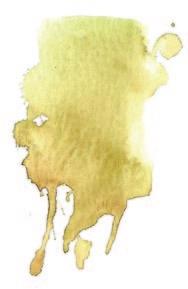 ART BY STAN FELLOWS
ART BY STAN FELLOWS
Willow Creek is nowhere. It’s one of countless unremarkable prairie streams too small and intermittent to float a boat but too deep and changeable to cross easily. Even during dry seasons, getting across requires finding a place where the sheer banks have sloughed away between pools of stagnant, fish-stranding water. Mule deer and cows cross here, and so do I, when I want to hunt the grassy coulees and crumbling badlands on the other side. uu

In Montana, dozens of Willow Creeks drain mountains and scour prairies. Most got their name because Beaver Creek was already taken, and also from the narrow-leafed shrub that holds their banks in thickets and tangles. Old-timers call it “coyote willow,” maybe because, wherever it grows, the banks are tacky with drying mud stitched with the tracks of wild canids snaking in and out of its shadows to surprise a jackrabbit or pounce on a vole. Thin and limber as shattercane and spiked with tiny yellow flowers in the spring, coyote willow is ever a sapling, throwing scarcely enough shade to cool a panting cow. In the throbbing summer heat, willow groves smell like the creosote ties of an old railroad.
In the fall, Willow Creek is everything. In a landscape defined by inch-high woolgrass and razoring winds, it’s a magnet for open-country mule deer that bed in its buckbrush bends and breed in leafless rattling thickets. In winter, sharptailed grouse descend out of the icy sky to tuck into streamside willows alongside twitchy prairie cottontails.
Willow Creek could be anywhere. Except mine is right here, meandering drunkenly through my northeastern Montana homeland as it transports the slurried prairie, stacking three miles of ropey twists into every map mile as it makes its way to the Milk River.
unsettling deluges. There are no chattering rapids here. Instead, the creek’s gurgle deepens as it swallows gumbo banks and rootwads in suctioning swirls. Its flow sometimes multiplies so silently and astonishingly that I’ve awakened to floodwater fingering across its mile-wide valley, an instant lake that reflects the sunrise with an intensity of light that I associate with seashores and snowfields. When the spring melt lifts and breaks ice into truck-size blocks, the creek mutters in the dark as tectonic plates of ice grind their way downstream, flattening willows and scarring the trunks of streamside cottonwoods.
While it can rise overnight, Willow Creek takes days and even weeks to recede, like a friend holding a grudge. The valley—after the water returns to the steep-sided channel— is hard to cross, all sucking mud and shipwrecked trees in a typically dry and treeless prairie. When floods arrive in the fall from November storms, I’m reduced to simply watching, through binoculars or spotting scopes, a parade of handsome bucks on the unreachable other side, killable but for the trench of hungry water between them and me.
Why do I care? There’s no shortage of deer or dry land elsewhere in my county. But those places don’t hold me in their sway, and a buck hunted on nearby Antelope Creek or Bitter Creek somehow isn’t the same as one that shares my unremarkable valley, hearing the same coyotes yip, waiting for the sun under the same high horizon.
For most of the year, my Willow Creek is nearly dry. If it weren’t for stick-and-mud beaver dams around every other bend that impound greasy water, I could hunt along its cracked bed for miles, invisible to bucks bedded on the adobe ridges. But for several weeks in late spring, Willow Creek swells and churns with spring runoff, a perilous boilage of cottonwood limbs and bloated yearlings, and, during an especially heavy flood a few years ago, rough-cut planks from a washed-out county bridge miles upstream.
Willow Creek never raises its voice, even during these
Its unremarkability is the source of my affection for Willow Creek, which fisheries biologists have told me is defined as a “degraded” waterway. Its banks are unstable and its flow is too sporadic to support a fishery. Wildlife biologists similarly dismiss much of the watershed’s terrestrial habitat. Bankholding riparian shrubs, the shady, buggy domain of summering sage-grouse, are the first to be grazed down by cows droughted out of the uplands. The adobe flats in its headwaters 50 miles to the southeast fail to slow precipitation, contributing to the cycle of flash floods followed by months of anemic alkaloid seeps that dry into cracked hardpan.
But degradation has a surprising upside. If Willow Creek were handsomer, I’d have more people clamoring to know her. If she held fish worth catching, I’d have to manage access

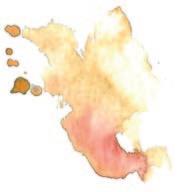
and expectations. If her flows were consistent, I’d be obligated to share her with floaters. Willow Creek’s impaired condition means she is largely unnoticed.
To me, that reduction has an unexpected amplitude. Once the creek dries down into a bed of cracking mud, I retrace steps I’ve taken for the past 20 seasons, passing bends where my kids killed their first deer, where I can sometimes jump a wood duck on a tannic pool skimmed with spearhead-shaped yellow leaves, and where buffalo bones poke out of a cutbank.
finally shingles, to burn. The lichened rocks on a grave dug in a hurry after an argument back in town.
Overlooking the creek and the leavings of those temporary honyockers, I find circles of head-sized stones that held the buffalo-hide skirts of Assiniboine teepees against the shouldering wind. Their campsites confirm that I’m only the most recent hunter to track deer into the willows.
Above the valley and the teepee rings, this is a country of squares, section lines and linear horizons, plumb-straight fences and alternating strips of winter wheat and summer fallow. This is one reason Willow Creek captivates me: It’s the only disobedient feature on a landscape that’s been mostly tamed by township and survey stake.
It’s in these times that Willow Creek switches from antagonist to partner. Mule deer that easily vault over barbed-wire fences don’t test the creek’s friable banks. Instead, they tuck into the willows, and if the wind is right and my approach is patient I can sometimes deliver an arrow or a bullet to a deer that thinks it’s hidden by the screen of slender trees.
Later, when the creek freezes solid, trapping carp and fathead minnows in blocks of brackish ice, I walk it with a shotgun. On days when the snow blows sideways, pheasants and sharptails tuck into streamside cover, watching for danger from overland, not from below. When flushed, roosters rocket straight into the pewter sky, squacking with surprise and betrayal, then fall to the ice, their gaudy plumage the only color of a monochromatic day.
Though I’m familiar with every brushy bend of Willow Creek through my place, upstream it’s a wilderness of remote hardpan flats and sage wastes, desolate tableland where even pronghorn don’t linger. It would take three days of walking from my house to reach its headlands in the rimrock country that tips south into the Missouri River Breaks. Along the way are skeletons of homesteads, stranded in the gumbo like beached boats, ribs of frame walls, shards of pottery, rusty bed springs, and the occasional harrow, teeth rusted and blunted from seas ons of unrequited efforts to turn this thin-lipped prairie into blooming field.
Way up Willow Creek are the sources of gossip that become history after a hundred years. The relics of the German’s shack, wallpapered with worthless banknotes from the Weimar Republic. Homestead remains of a family that froze to death when they ran out of punky wood and cow pies, and
Meanders are a gift of moving water, whether it’s a tasty trout riffle on a mountain creek or the lazy comma of a prairie catfish river’s inside bend.
On a live stream, curves slow the descent of water, but they also ensure that every moment is distinct from the one just before it, or the one yet to come. It’s unimportant whether you use that knowledge to catch a fish or time a leap or shoot a buck. It’s the unrepeatable moment that matters.

Across the West, including my neglected corner of Montana, public agents and irrigation masters have an enduring affection for reservoirs. What greater gift could land reclaimers give to arid regions than consistent water?
But the bargain never seems square. Many like me have stood on the lifeless, baked-mud shore of a drawn-down Western reservoir and wondered at the alternative—a wild-eyed creek or cheerful river chattering its way through a handsome valley, somehow made bigger by moving water.
If dam-builders only see degraded Willow Creek at flood stage, its greedy whorls lapping at bankside willows and gobbling up real estate, it’s an easy argument to tame it. But then the water drops and the streamside grass thickens calves and fattens fawns. Thrushes and meadowlarks and black-and-white kingbirds ch atter and flit in glossy new buckbrush. On hazy summer evenings, the hills soften to purple and gray. At the center of it all is the creek, obeying only the pull of gravity, distributing exactly as much life as it withdraws.
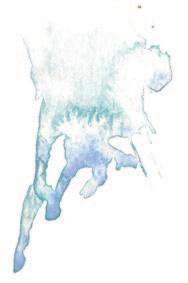
SIMILAR SIBLINGS Two-year-old bear siblings feed on grass in the Paradise Valley. At this age, young bears often are pushed out by their mother to begin life on their own. Grizzly siblings similar to this pair wandered throughout the Bitterroot Valley last summer before being captured and relocated in the nearby Sapphire Mountains.
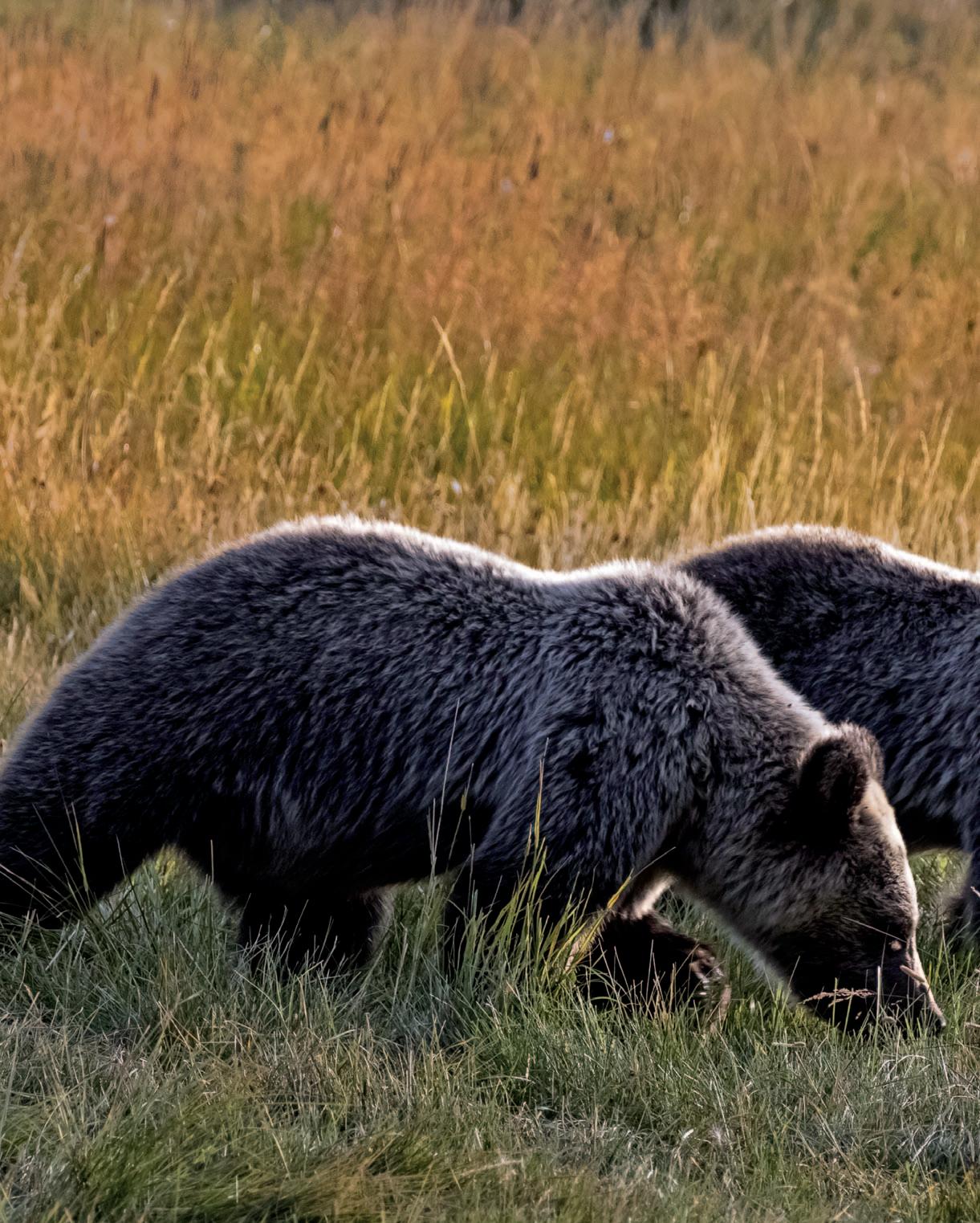 By Julie Lue
By Julie Lue
Young grizzly siblings’ high-profile journey to the Bitterroot Valley leads to an unexpected ending.PHOTO BY DUANE HUIE
The first week in August last year was a busy one for two subadult grizzlies on the move in western Montana—and for Montana Fish, Wildlife & Parks employees who received a flurry of reports about the pair acting “young and dumb,” in the words of Missoulabased FWP bear specialist Jamie Jonkel.
Eyewitness accounts, videos, and trail camera photos revealed details of the bears’ journey from the Blackfoot Valley to the northern Bitterroot, where they spent the next two months crisscrossing a key travel corridor used by many wildlife species.

It’s normal for young bears to disperse as they seek their own home range, and also to occasionally use poor judgment as they learn how to survive without their mother. The two-year-old male and female grizzlies—assumed to be siblings—attracted plenty of attention along their southwesterly route. They were first spotted on August 3 on Montana Highway 200 near Potomac, about 30 miles east of Missoula, eating a road-killed deer. The next day, a homeowner photographed the pair walking up the hill behind her house about 20 miles southeast of Missoula. Three days later, they were seen on Interstate 90, eating roadkill again, as traffic whizzed by at high speed. By August 8, the bears had crossed the freeway and triggered a trail camera on the 15,000-acre MPG Ranch east of Florence. And then the siblings dropped down to the floor of the Bitterroot Valley, home to valuable wildlife habitat as well as a rapidly increasing human population.
That put the young bears just a short ramble from the edge of the Bitterroot Ecosystem, one of six grizzly recovery areas established in 1993 under the Endangered Species Act. But this recovery area—which comprises the SelwayBitterroot and Frank Church-River of No Return wilderness areas, mostly in eastern Idaho —hasn’t held a resident grizzly population for about a hundred years.
In the early 2000s, grizzlies began making occasional appearances in the Bitterroot Valley and surrounding mountains, likely just passing through as they traveled outside of grizzly population centers to the north—in the Selkirk, Cabinet-Yaak, and Northern Continental Divide ecosystems— and the southeast, in the Greater Yellowstone Ecosystem. Grizzly sightings have become more common in the area over the past decade, according to Jonkel. But no female has stuck around and raised cubs, a critical first step to reestablish a Bitterroot population.
Once they arrived in the valley, the young grizzly siblings spent much of their time on large agricultural properties, says Julie
Bruce Montgomery, FWP’s first Bitterroot bear management specialist, who was hired in May 2022. The bears did not pose a threat to people. When a rancher startled the two bears in a creek bottom, Montgomery says, “They ran out of there soaking wet at 100 miles per hour in the other direction.” The bears were also seen running away from cars on rural roads.
But the situation was tenuous for the naive young grizzlies. They crossed busy U.S. Highway 93 multiple times between Florence and Lolo, in an increasingly developed area that remains a critical passage for wildlife, including elk herds often seen from the road. This stretch can be difficult for animals to cross safely; a high percentage of crashes here are due to wildlife-vehicle collisions.
While moving between large properties, Montgomery says, the siblings were also traveling close to unnatural food sources. “They were starting to pass by homes and unsecured chicken coops and walking right by trash cans.” It seemed only a matter of time before they followed in the footsteps of
OKAY, KIDS, PARTY’S OVER Above: FWP wildlife technicians Eli Hampson and Brad Balis take blood samples and body measurements of the 230-pound male sibling captured on September 30, 2022. The 172-pound female sibling (below left), captured on October 2, and the male (below right) were released in separate locations but apparently reunited on their own 11 days later, likely where they were born, in the Scapegoat Wilderness, more than 75 miles away (see map at right).
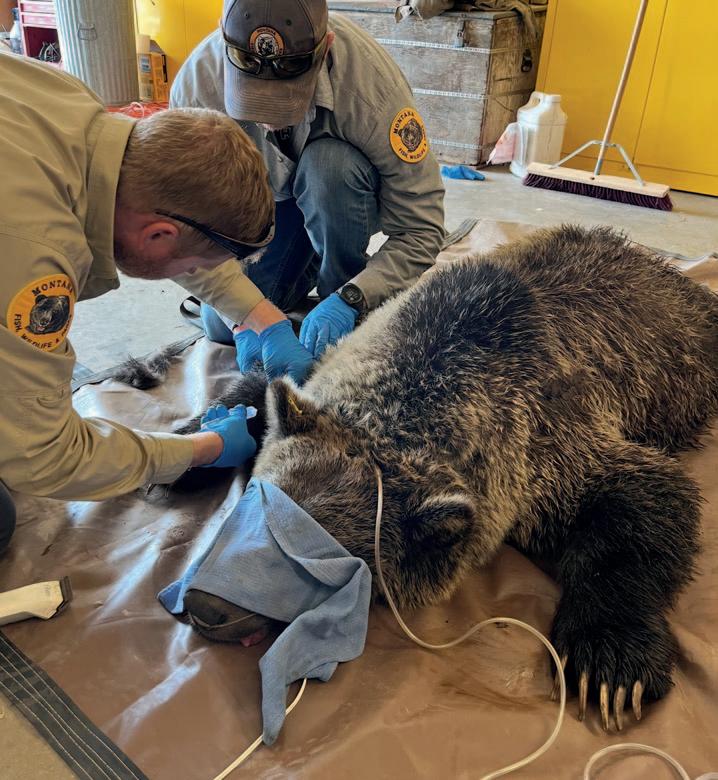
the valley’s numerous black bears, many of which have become food-conditioned.
Up to 90 percent of what black bears and grizzlies eat can be plants, and they have a hard time passing up easy meals in the form of unsecured garbage, seed in bird feeders, pet food, and fruit trees. Bitterroot Disposal and Republic Services is working to offer more bear-resistant garbage containers to local homeowners, and some valley residents are taking steps to make attractants off-limits to bears. But communities don’t become bear-safe overnight.
FWP managers working with the U.S. Fish & Wildlife Service decided to trap and
relocate the grizzly siblings. Jonkel stresses that this was a preemptive capture, designed to move the bears before they got into trouble. “They were starting to show some indications that they were feeling comfortable around people,” he says. “For example, they were at several houses eating apples and
people were concerned, though there were no issues other than the bears being at the edge of the property eating fallen fruit.”
Jonkel adds that several photos posted to social media showed the bears at empty garbage cans. “We want to make it clear that, to the best of our knowle dge, there


This is something we have not really considered before....
Bears keep showing us new things.PHOTOS: MONTANA FWP Julie Lue is a writer in Florence.
were no food rewards at these cans. But the bears were starting to show some interest, which is why we thought it best to preemptively trap and transport them.”
Montgomery spent a lot of time moving culvert traps as he tried to predict where the bears would pop up next. “When you’re trapping bears, you tend to be a day behind if they’re bouncing around like those two were. They were just all over the map,” he says. Several landowners provided essential assistance. “They were great to work with, and a lot of them didn’t even mind that the bears were there,” Montgomery adds.
FWP officials hoped to relocate the siblings together. But they trapped the male first on September 30, and had to relocate him. “We couldn’t keep him in the trap any longer,” Jonkel says. Two days later, they captured the female. Jonkel credits Montgomery with “finding two needles in a really big haystack.”
It was “monumental” to confirm the presence of a female grizzly in the Bitterroot area, Montgomery says. “If you don’t have females, you can’t have a population.”
According to FWP bear biologist Cecily Costello, males tend to disperse farther than females; a female will usually end up with a home range that overlaps her mother’s. “But long-range female dispersal sometimes occurs, and perhaps a female tagging along with her wandering brother is one way it happens,” she says. “This is something we have not really considered before as a way females could disperse long distances. Bears keep showing us new things.”
After the grizzlies were captured, biologists anesthetized the bears; took blood, hair, and tooth samples; and applied tags and collars. The youngsters, which Jonkel refers to as “furballs,” appeared almost more hair than bear. The male and female weighed in at
around 230 and 172 pounds, respectively.
The bears were released a few days apart in the nearby Sapphire Mountains close to the Welcome Creek Wilderness, in a relocation site previously approved by the Montana Fish & Wildlife Commission for nonconflict bears. Bear managers wondered if the siblings would stick around, or even head west to the Bitterroot Recovery Zone, but instead, “they ended up bolting for what is probably their natal home range in the Scapegoat Wilderness,” Montgomery says.
This time, the bears were wearing GPS collars that recorded their separate journeys after release. A map of their routes appears much less random than the earlier trek to the Bitterroot.
The young male initially traveled south to the Burnt Fork and then returned to the
release site. But his sister had already taken off, heading toward Drummond; she managed to cross I-90 on her second try and continued on to the Lincoln area. Meanwhile, the male also headed northeast but crossed the interstate near Ryan Creek and traveled through the Blackfoot River area. As they approached the Scapegoat Wilderness, the bears’ paths began to converge. And then one day the radio collars showed the siblings to be in exactly the same place, more than 75 miles from their release sites.

“They appeared to have joined up again on Scapegoat Mountain,” says Jonkel. “We believe they were in a den together, hibernating.”
No one knows where these two young grizzlies will head this year now that they’ve emerged from hibernation, or whether they will ever return to the Bitterroot. “They’re just young bears going out exploring country, trying to find their place in life,” Montgomery says. But he and other FWP bear managers say Bitterroot residents should be prepared to encounter both grizzlies and black bears in the area. FWP offers bear safety programs that teach participants how to use bear spray and keep tempting foods, from trash to apples, away from bears so they don’t venture into human settlements.
Preventing conflicts with bears is much more effective than trying to solve problems after they’ve occurred, says Montgomery, who spends much of his time trapping problem black bears and providing advice and help to Bitterroot homeowners. “If you secure your stuff, you probably won’t have any trouble with either black bears or grizzlies.”
HOMECOMING? After being captured, fitted with GPS collars, and released in the Sapphire Mountains, the two grizzly bears independently headed northeast. Biologists tracking the pair were surprised to see them travel to the same area, where it appears they may have denned together, likely in their natal range.
For more information on bear safety programs or advice on securing attractants, please call the FWP bear specialist in your area. In the Bitterroot Valley, call Bruce Montgomery at 406-422-6184.
Contrary to what your ill-informed uncle told you years ago, suckers are remarkable fish and among Montana’s most ecologically important species.
 BY TOM DICKSON
BY TOM DICKSON
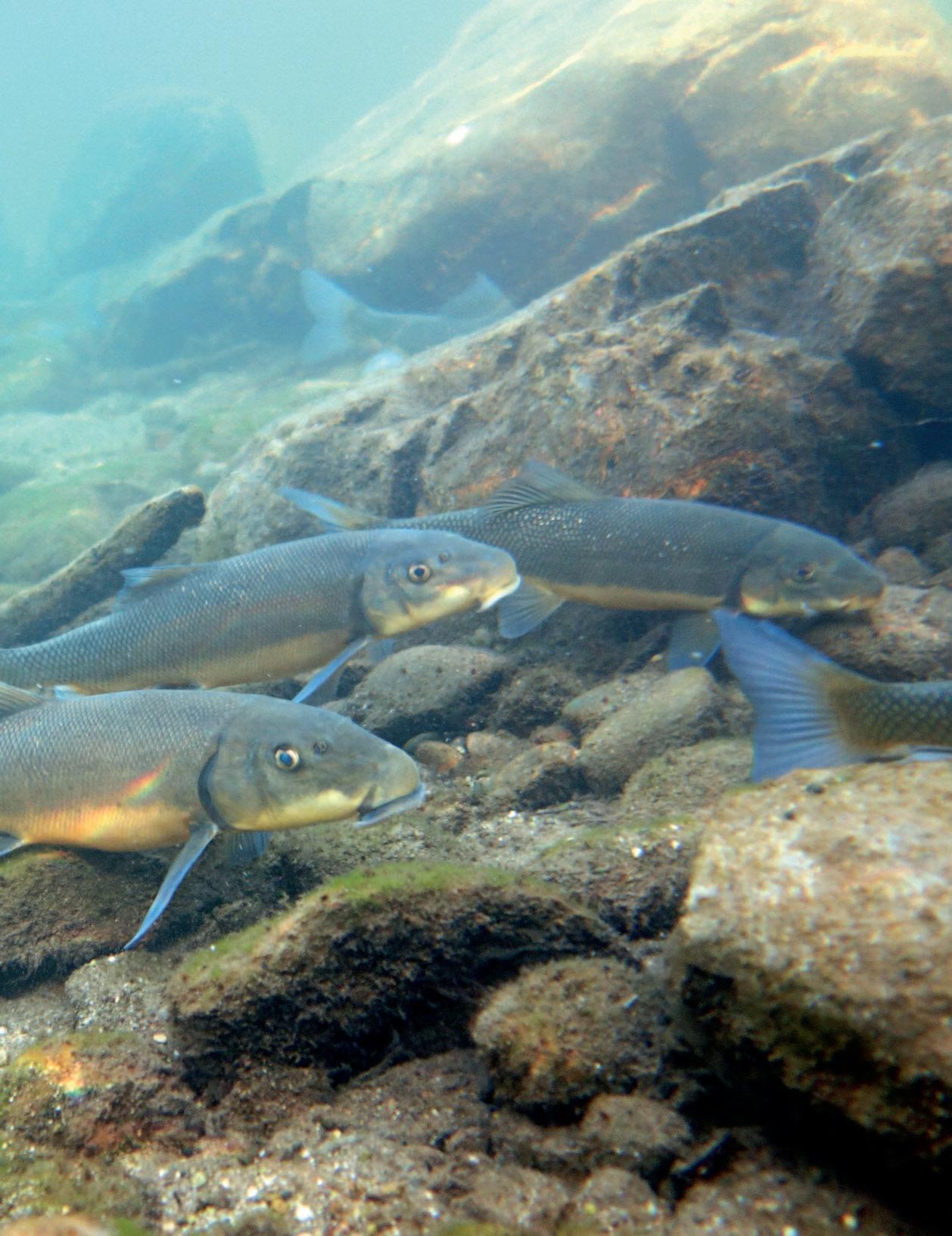
As he stood on the bank, Schmetterling recalls, he watched “hundreds of thousands of fish in this dark mass the size of a football field swimming in the pool below the dam.” The fish were driven by ancient instinct to return to their natal waters up the Blackfoot or Clark Fork to spawn. Day after day, they tried to leap onto and shimmy up the dam’s concrete apron. “It was like watching salmon in Alaska,” Schmetterling says.
Montana suckers resembling salmon?
It turns out that’s not the only thing about these large, lipped, bottom-hugging fish that
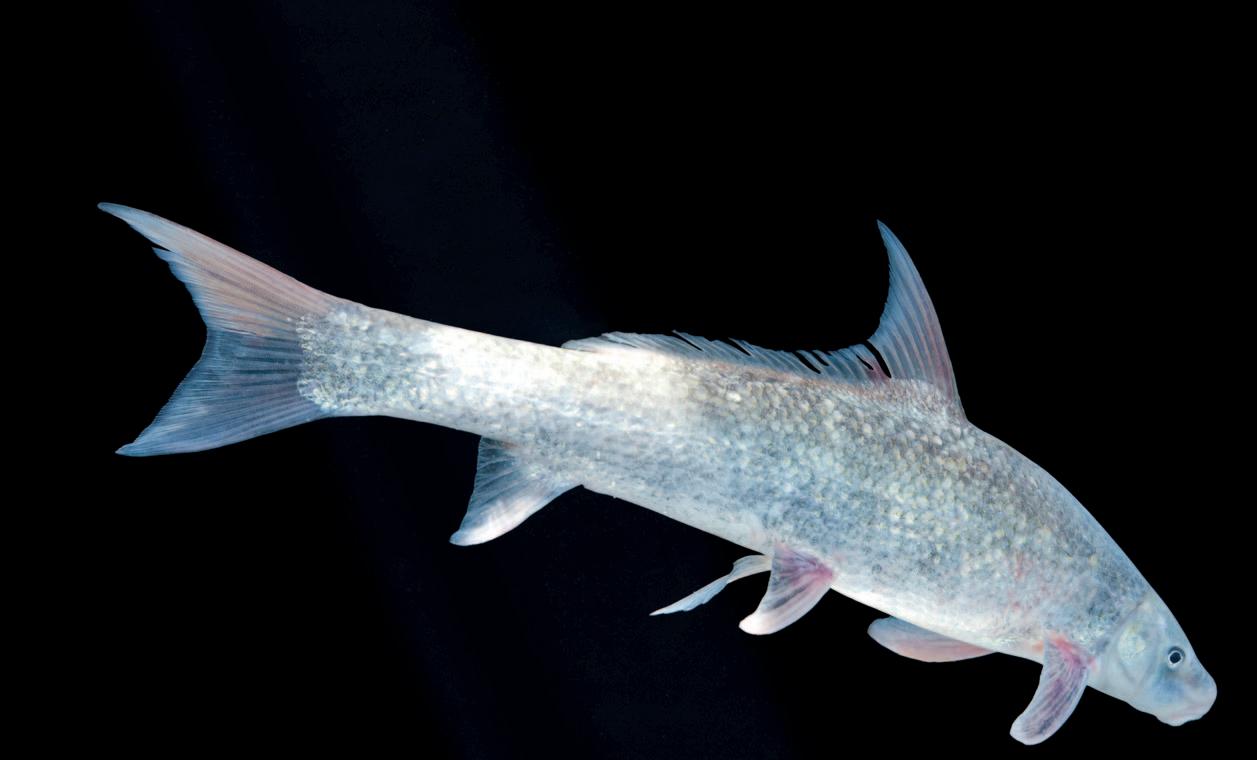
most people don’t realize. Contrary to longstanding misconceptions perpetuated by anglers who often have no idea what they’re talking about—that’s you, Uncle Mitch— suckers rarely displace trout or walleye, don’t feed on underwater garbage, and don’t prefer (much less cause) dirty water. They can also be delicious to eat.
In fact, for years most people have been, well, suckered into gullibly swallowing misinformation about these beautiful, fascinating, and essential creatures of Montana’s stream, reservoir, and river ecosystems.
THE MOST NORTH AMERICAN OF FISH Suckers are a fish family, Catostomidae, composed of 80 species, all but two living only on this continent: the longnose sucker, which is also found in Siberia, and the Chinese sucker, which swims exclusively in the Yangtze River drainage. “You could say that suckers are the most North American of all fish families,” says Schmetterling, today head of FWP’s fisheries research program.
Catostomidae members can be grouped into four categories: buffaloes, carpsuckers, redhorses, and regular suckers. Montana is home to nine species: bigmouth buffalo, smallmouth buffalo, river carpsucker, shorthead redhorse, largescale sucker, longnose sucker, blue sucker, plains (previously mountain) sucker, and white sucker. Biologically, these and all other suckers are distinguished by their soft-rayed fins, toothless jaw, and scaleless head. Most species also have the characteristic subterminal (below the head), lipped mouth.
The sucker family gets its name from the way most members use their mouth to vacuum up aquatic insects and algae. Dense
avid Schmetterling recalls the awe he felt while staring down at the mass of largescale suckers milling below Milltown Dam, about 8 miles east of Missoula.
“They were absolutely incredible,” the Montana Fish, Wildlife & Parks fisheries biologist says. It was 1995, and Schmetterling had been hired to study how the dam, built in 1908 to impound the Blackfoot and Clark Fork rivers at their confluence, affected fish movement.BIG-RIVER BEAUTY With its striking steel blue coloration and dashing dorsal fin, the elegant blue sucker is the aristocrat of the Catastomidae family. Found mainly in southern and midwestern states, the species makes its way into Montana as far as the lower Missouri and Yellowstone rivers.
with nerves, the highly sensitive mouth helps a sucker find and dislodge food from a river or lake bottom that lipless fish often can’t reach.
As these indiscriminate feeders hoover up anything that looks even remotely edible, they regularly swallow anglers’ worms and other baits without hesitation—behavior that inspired the term “sucker” for a person who is easily duped.
Due in large part to their feeding abilities, suckers have been so historically abundant and widespread in Montana that river ecosystems can’t fully function without them, Schmetterling says. As suckers feed, they convert aquatic insects and algae into fish protein that moves throughout the watershed as the fish swim upstream. Depending on the species, a single female sucker produces between 50,000 and 300,000 eggs each spring. “When suckers spawn, most of their eggs stick to rocks, but many drift downstream where they are eaten by aquatic insects and other fish,” Schmetterling says.
After the eggs hatch, many larval suckers become food for other species, as do young suckers. Sucker body waste and milt (semi-
nal fluid) also add vital nutrients to streams and rivers. Spawning adults congregating in shallow riffles are easy prey for ospreys, mink, and other piscivores. When the fish die, sucker bodies that aren’t consumed by

scavengers like bald eagles, bears, and crayfish decompose, adding even more nutrients to the system, similar to how salmon enrich entire Alaskan and Canadian watersheds.
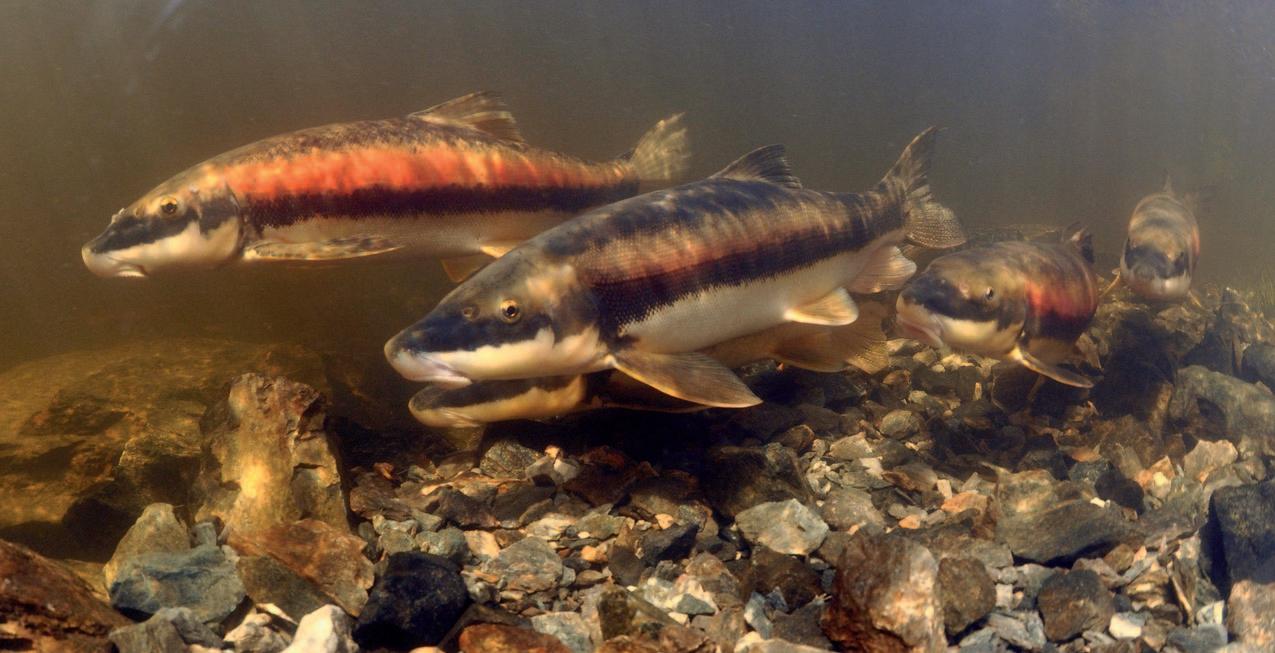
Ontario scientists who studied a Lake Superior tributary found that, in stretches containing suckers, algae was nine times more abundant, invertebrates were twice as dense, and fish biomass was eight times greater than stretches without suckers. “Here in Montana, it would be impossible to fully restore a river like the Clark Fork without suckers and their essential transfer of nutrients throughout the system,” Schmetterling says.
Catostomidae members are also marvels in other ways. “Many sucker species are incredibly powerful swimmers, migrating 100 miles or more upstream each year to spawning beds,” says Zach Shattuck, an FWP native fish species coordinator. As with bull trout and westslope cutthroat trout, suckers develop acute homing abilities, keying on the smells of natal streams to return to where they were hatched so they can provide their own offspring the same optimal conditions.
Like elephants, parrots, and
can be remarkably
that
lived.
Many species are incredibly powerful swimmers, migrating 100 miles or more upstream each year to spawning beds.”
individuals in Montana to reach 40, 50, or even 60 years old—ages determined when biologists count the annual rings formed in calcium deposits, called otoliths, in the fishes’ inner ear. In 2019, fisheries scientists in Minnesota verified that a bigmouth buffalo there was 112 years old, having hatched when Theodore Roosevelt was president.
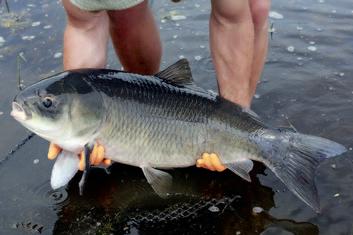
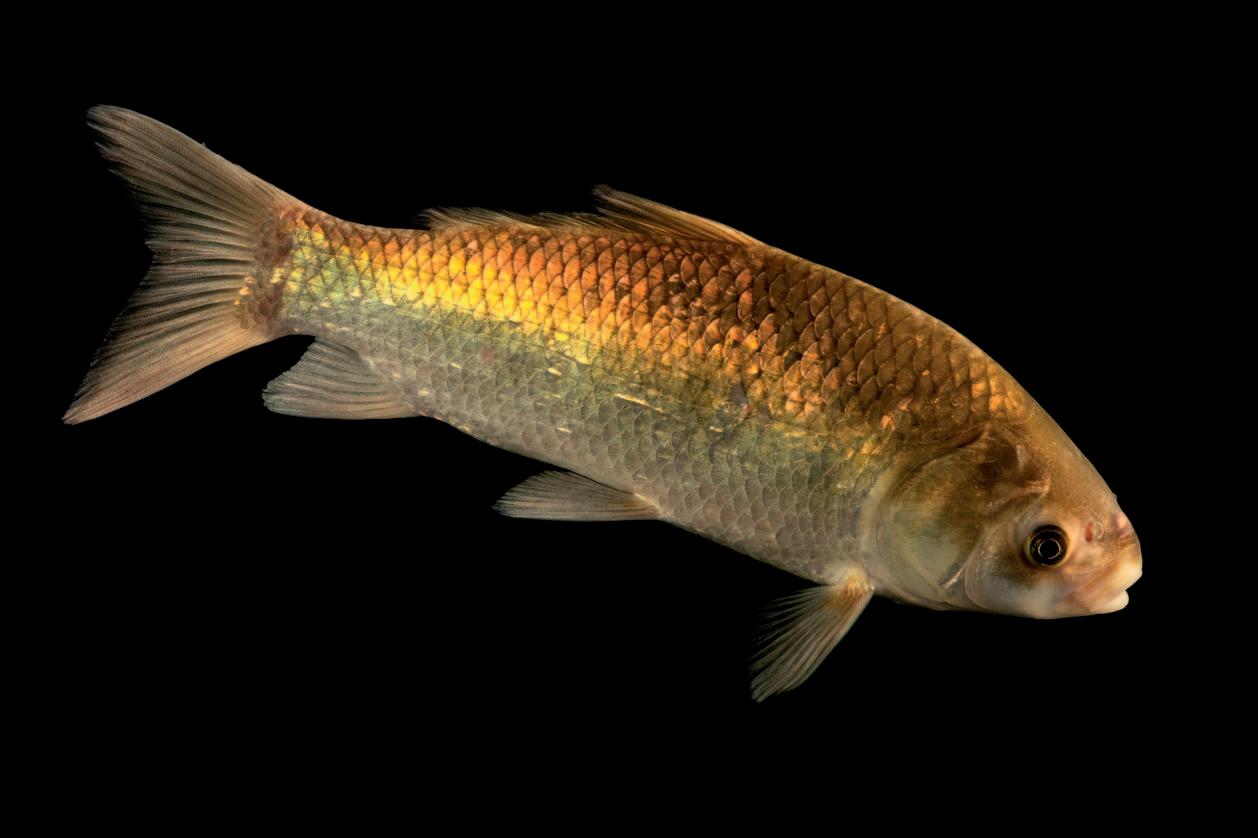
The sucker family is remarkably diverse. While most trout species look pretty much the same except for coloration, suckers range widely in shape, size, and habitats—from sleek 7-inch-long plains suckers in high-altitude streams to beefy bigmouth buffaloes, which can reach nearly 60 pounds in Montana as they swim through large reservoirs and slowmoving rivers feeding on zooplankton.
Though not recognized as such, many sucker species cut a handsome figure, with large pectoral and tail fins that propel their torpedo-shaped bodies through the water. Suckers are often drably colored to avoid predators,
but some spawning males are striking. The male longnose sucker, for instance, sports a bright red band along its dark sides. Topping the blue sucker’s steel-hued body is a sickleshaped dorsal fin, a dashing feature also found on shimmering silver river carpsuckers.
Perhaps most remarkable, says Tom McMahon, recently retired professor of ichthyology at Montana State University, is how every sucker species has a differently shaped and angled mouth and lip structure. For instance, a longnose sucker’s lips sit at the end of an elongated snout, allowing the fish to wedge its
mouth deep into crevices to find food. A blue sucker’s lips are covered in wartlike bumps that create additional sensitive surface area for locating a meal. Plains suckers use their hard, flat, spatula-like lower lip to scrape nutritious algae off rocks. “The lip diversity appears to be various adaptations for feeding in different aquatic environments,” McMahon says. “That could account for how abundant and
Bigmouth buffaloes can reach nearly 60 pounds in Montana as they swim through large reservoirs and slow-moving rivers feeding on zooplankton.”FROM TOP: JOEL SARTORE/PHOTO ARK; NORTH DAKOTA STATE UNIVERSITY WHAT A BIGMOUTH The bigmouth buffalo is the only member of the sucker family in Montana with a terminal (at the front) mouth. Unlike its cousin suckers, which feed mainly on the bottom, bigmouth buffaloes cruise the main water column filtering zooplankton with gill rakers. Tom Dickson is the Montana Outdoors editor.
ID tips: Average size 12 inches. Golden sides, red or orange tail and pectoral fins.


ID tips: Average size 14 inches. Dark brassy sides and upper head with cream lower head, lower body, and underside, with dark fins.
ID tips: Average size 13 inches. Olive sides with white underside, narrow tail base.
ID tips: Average size 7 inches. Extremely narrow body. Dark back and upper sides with dark specks or mottling. Lower body is whitish.

ID tips: Average size 13 inches. Long snout with olive back, upper sides, and head. Spawning males sport red sides above a dark band.

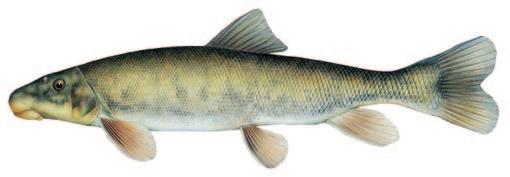

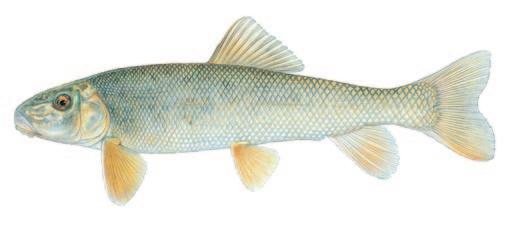
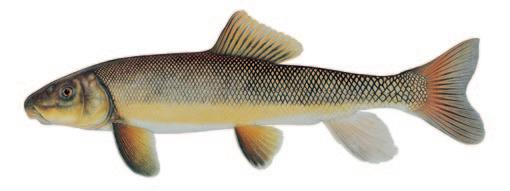

ID tips: Average size 26 inches. Narrow head rising in back to a tall body, then narrowing again to the tail to create an overall “shallow pyramid” profile. Body is bluish to dark olive with a white underside. Sickle-shaped dorsal fin.
ID tips: Average size 29 inches. Distinctive terminal mouth (front of head) differs from the subterminal mouth (below head) of other suckers. Dark body, often with a coppery sheen, and dark fins. Light underside.
ID tips: Average size 23 inches. Bronze to slate top and sides with a light underside. Dark fins. Mouth angles down at a 45-degree angle.
ID tips: Average size 17 inches. Bright, silvery sides, brown or olive back, white underside, and light lower fins. Tall back and sickle-shaped dorsal fin give it a “shallow pyramid” profile.
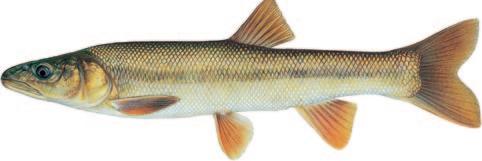
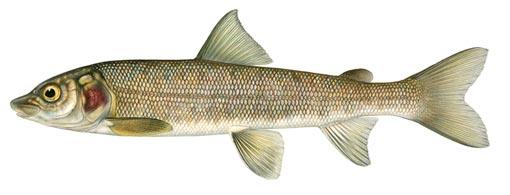


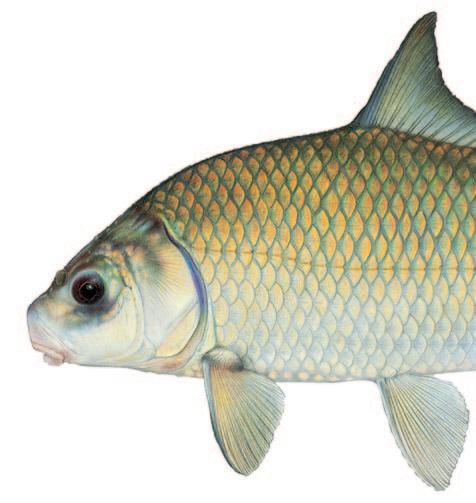
Distinguishing nonsucker feature: Pair of small barbels (whiskers) on either side of upper jaw, hard spine on leading edge of the dorsal fin.
Distinguishing nonsucker feature: Mouth is not rubbery.
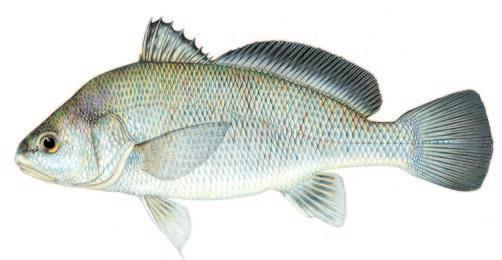
Distinguishing nonsucker feature: Rounded tail, larger mouth with white lips, long dorsal fin has notch in the middle and spines in the front half.
Northern pikeminnow
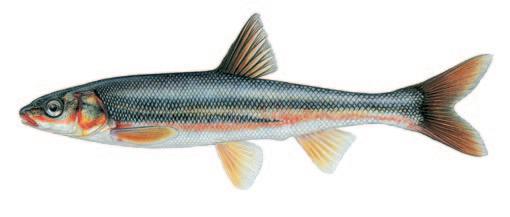
Distinguishing nonsucker feature: Large flat mouth is at the front of a flattened head and not rubbery. Deeply forked tail.
Peamouth
Distinguishing nonsucker feature: Small mouth is at the front of the head and not rubbery. Deeply forked tail.
Carp have a hard catfish-like spine at the front of the dorsal fin. Suckers have an entirely soft dorsal fin.
Carp have two small barbels on either side of the upper jaw, like a mustache. Suckers have no barbels.
widespread suckers are.”
And because suckers eat many foods that trout and other species can’t reach or process, like snails and mussels, it could also account for why they can produce large populations without reducing numbers of game fish in the same waters.
Despite their many attributes, suckers have been smeared with a bad reputation. One reason is the very mouth that allows them to feed so successfully. The fleshy, rubbery orifice and protruding lips look a bit too human for some anglers, who cringe when wresting out a hook.

Another strike is the resemblance of some sucker species to the common carp, an invasive species originally from Europe and Asia. (It doesn’t help that one group of suckers is called carpsuckers, probably named by Europeans who thought they resembled the Cyprinus carpio back home.) Because many anglers hate carp based on a mostly mistaken belief that the fish harm game fish populations, suckers are similarly disdained.
Much of the prejudice against what are grouped together as “rough fish” (also known as “trash fish”) comes from the ability of carp,
white suckers, freshwater drum, and several other species to survive in warm, polluted water. A common misbelief is that these fish actually prefer dirty rivers and lakes. Some

anglers even maintain the fish cause the degradation. They don’t.
But we do. Before Congress enacted the Clean Water Act, cities, towns, and factories piped human waste, industrial chemicals, and other pollutants into lakes, streams, and rivers across the United States. Degradation continues today, though to a lesser degree, with leaky septic systems, feedlot runoff, and other “nonpoint-source” water pollution not regulated by federal law.
Rough fish, whose only “crime” is surviving in water too filthy to support species like trout and walleye, became scapegoats. “No fish chooses to live in dirty water, and some sucker species, like the plains sucker, actually need cold, clear streams to survive,” Schmetterling says.
Shattuck notes that anglers also deride suckers as “bottom feeders.” It’s an odd sentiment, like being disgusted by lambs because they eat off the ground. “Most fish species, game and nongame, feed from river and reservoir bottoms. That’s where most of the food is,” Shattuck says. “And even though predator fish such as walleye and bull trout usually don’t feed directly off the bottom, they eat plenty of fish that do.”
Suckers are also wrongly accused of
The diversity of sucker lip shapes and structure appears to be various adaptations for feeding in different environments.”
threatening salmonid populations, Schmetterling adds. “Yes, some trout eggs are ingested as suckers consume their usual foods like algae and aquatic insects, but not nearly enough to harm trout populations.” He notes that trout and suckers have coexisted for millions of years. “In fact, without abundant sucker populations and all the nutrients they add to river systems, Montana would likely have far fewer trout,” Schmetterling says.
Because suckers are so successful at feeding and reproducing, they account for vast amounts of biological matter, known as “biomass,” in river systems. The largescale sucker, for instance, is the most abundant species in the Columbia River drainage, Schmetterling says, adding that their very profusion may add to suckers’ poor reputation. “Some anglers think that all those spawning suckers they see in spring are crowding out more desirable fish like trout, or taking all their food,” he says.
Speaking of food, another sucker myth holds that the fish are inedible. True, they do have bony meat (as do trout and salmon), but people have been dining on suckers for thousands of years. Native people trapped

spawning suckers in weirs, consuming the eggs and preserving the meat with smoke. Pioneers and then rural Montanans well into the 20th century netted and gigged white
and blue suckers for canning and smoking. Bones are easily picked out of smoked or canned meat and can be made edible in fried fish by scoring the fillet with a knife beforehand to allow cooking oil to penetrate and soften the ribs. East of the Mississippi River, bigmouth buffalo, smallmouth buffalo, and other commercially harvested suckers are still commonly sold as food fish, especially in Asian markets.
A small but growing number of anglers recognize the fine taste and sport of suckers. Foremost are “rough fishers,” who post on the roughfish.com blog and celebrate the biological diversity of suckers and other fish species they catch. Some maintain rough fish “life lists,” just as birders do.
Few Montana anglers appear ready to join the sucker celebration. Schmetterling says he currently sees little interest among the mostly trout- or walleye-focused anglers he meets while working during the week or fishing on weekends. “It’s such a missed opportunity,” he says. “Given the diversity of the fish themselves and the habitats they inhabit, fishing for suckers and other socalled rough fish is a great way to learn about what goes on below the water’s surface.”

Given the diversity of the fish and their habitats, sucker fishing is a great way to learn about what goes on below the water’s surface.”FROM TOP: NATHAN ABBOTT; MONTANA FWP HANDSOME LITTLE FELLA Averaging just 7 inches long, the plains sucker is Montana’s smallest member of the Catostomidae family. During spawning season, males show a bold red side stripe similar to that on longnose suckers. Plains suckers are found only in clear mountain streams east of the Divide.
White sucker Catostomus


Largescale sucker Catostomus macrocheilus
Longnose sucker Catostomus catostomus
Plains sucker (previously mountain sucker) Pantosteus jordani
Shorthead redhorse Moxostoma macrolepidotum

 Blue sucker Cycleptus elongatus
Blue sucker Cycleptus elongatus
t happens every spring when I am out hiking. Upon hearing a sweet song unlike any other, I raise my binoculars to identify the singer, and soon it appears—a small bird with a scintillating turquoise head. “Ah, yes,” I tell myself. “That is the song of the lazuli bunting. Gotta remember that one.” A few minutes later, or perhaps the next day, I hear another intriguing,
sweet melody, different from the first. Again, I stop, glass, and see…another lazuli bunting! Inevitably, this process repeats itself several more times, each revealing a different lazuli bunting with a different song. Inevitably, I despair at ever being able to identify this species by ear.
It was in part this frustration, however, that led me to learn more about the befud-
dling world of bird vocalizations and just what the heck birds are singing about. Turns out, it’s a question one of Montana’s top ornithologists has been trying to answer, too.

Erick Greene is a professor at the University of Montana’s Division of Biological Sciences and former director of UMBEL (Uni-
A University of Montana ornithologist explains what chickadees, buntings, and nuthatches are really communicating when they fill the forest with sound.
versity of Montana Bird Ecology Lab). As a youth, he played the harpsichord, organ, and “weird medieval instruments” and almost pursued a career in music. Instead, his musical inclinations helped lead him
into a lifetime of learning about birds— especially the sounds they produce. The first thing he emphasizes is that birds generally have two distinct types of vocalizations: songs and calls.
“Songs are only one small bit of the vocalizations that birds make,” Greene explains, “and songs in general have two functions. One is what we call male-male interactions.”
Consider a lazuli bunting or American robin singing at the top of a tree. “That’ll be a male,” Greene says. “Female buntings and robins don’t sing. That song is staking out real estate and is directed at other males. It’s saying ‘This is my territory. This is my chunk of real estate. Don’t come in or I’ll beat you up.’ The songs are directed against other males, but they also aim to attract females. They say, ‘Hey, I’m a stud. I’ve got this great real estate. Come check me out.’”
More often than not, bird songs are melodious, complex, and delightful for us humans
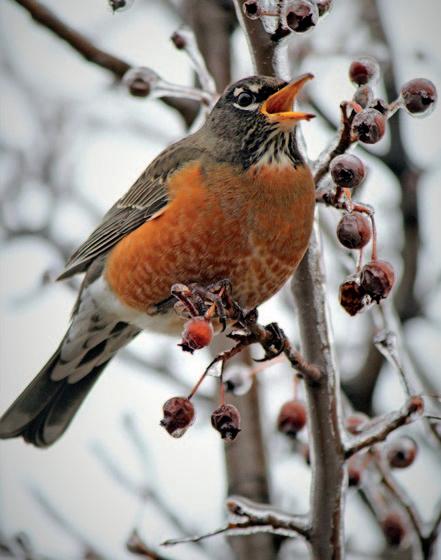

to listen to. They contrast sharply with the second category of bird vocalizations, what ornithologists refer to as calls. Calls are chips, tseeps, chuffs, and other, usually short, vocalizations that have nothing to do with courtship or territorial defense.
Calls are used for everything else. “Contact” calls help birds pinpoint each other’s locations or stay together in a flock. Other calls may alert chicks that they are about to be fed. Some of Greene’s most fascinating research involves calls that communicate threats.
Interestingly, one of the bird world’s most famous calls—the chicka-dee-dee-dee of the black-capped chickadee—is usually mistaken for a song. “The chickadee’s song is actually a clear, three-note whistle that many people describe as sounding like cheese-burger or fee-bee, and chickadees are singing the exact same song all across North America,” Greene says.
So what is the chicka-dee-dee-dee call? Greene describes it as a “Swiss army knife call” with many different functions, especially to warn of danger.
“In winter,” he says, “we tend to see these stable mixed-species flocks with lots of different birds hanging out together. Around here, you’ll typically have chickadees and nuthatches and maybe some other species. Chickadees detect predators quickly and sound their alarm calls immediately. Nuthatches absolutely understand chickadee signals, and they respond appropriately.”
Greene pulls up a fascinating video of an experiment he did with high school student Dylan MacArthur. They installed a speaker in the woods near Missoula. When they played the calls of a northern pygmy-owl, one of a songbird’s most potent predators, the black-capped chickadees sounded the alarm first and began mobbing the speaker. The nuthatches hung back for a minute, but finally decided the owl calls posed enough of a danger to join in and
Hey, I’m a stud. I’ve got this great real estate. Come check me out.”STUDLY STATEMENT A male lazuli bunting (above) and male American robin (right) sing to announce their territory to other males and let females know they have some “great real estate.” LEFT TO RIGHT: CHUCK HANEY; SHUTTERSTOCK
continued sounding the alarm—a kind of mer-mer-mer—long after the chickadees determined the danger had passed, quit calling, and resumed their usual activities.
“Chickadees and nuthatches are clearly sharing information,” Greene explains. “They’re paying attention to each other, but by having multiple species that respond behaviorally in different ways, the whole warning system is more than the sum of the parts. And even though chickadees tend to respond earlier and shut up earlier, they’re still paying attention to the nuthatches.”
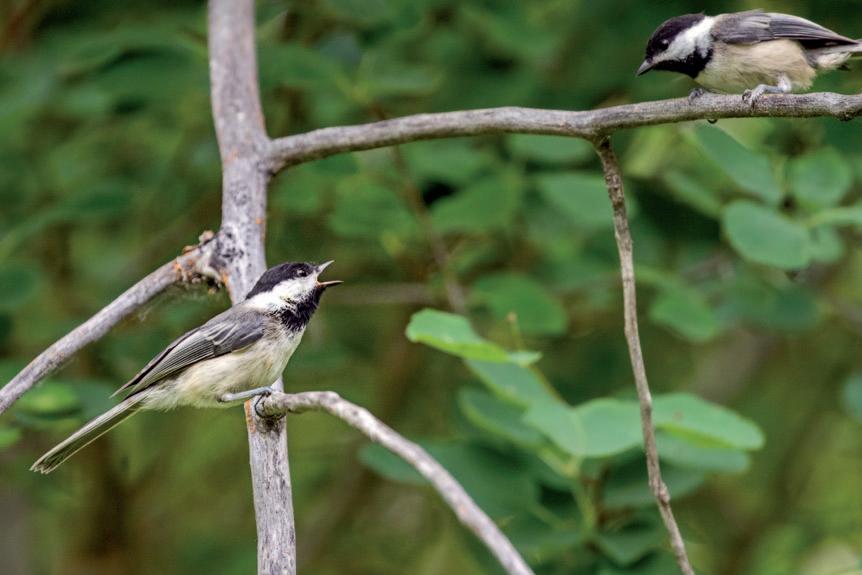

There is even more to these alarm calls.
Nuthatches alter theirs based on whether they perceive a threat firsthand from direct observation, or whether they are just hearing the news from chickadees—what Greene humorously refers to as the original “tweeting.” The nuthatches relay information about the threat level through the intensity of their calls. Not surprisingly, squirrels, chipmunks, and other animals understand and pay close attention to these calls, too.
As complex and useful as bird calls can be, bird songs are not to be outdone. Greene explains that even though all chickadees sing the same three-note song, they can use
these simple notes in complicated vocal contests. “Say there are two males interacting. They’re singing the same thing, but they may engage in a kind of ‘Dueling Banjos’ contest, and how they modulate their message is by pitch.”
Greene whistles the chickadee song at low pitch, explaining that you might first hear something similar from one male if two are singing. “But then the other might jack up the pitch so he’s singing higher, an increase in aggression, and so the first male matches it. It’s like ‘Oh yeah, buddy? Come on, bring it on.’ You can have these escalating duels where you hear the male chickadees singing higher and higher. Conflict deescalation happens when one bird switches to a lower pitch. Listen for that in the spring. It can be really, really obvious.”
Songs can also perform more complicated social tasks—which brings us back to those befuddling lazuli buntings. It turns out that each male lazuli has its own distinct song, a unique combination of sounds chosen from more than 140 different syllables in the lazuli vocal library. As with most other bird songs, the lazulis’ help define territories
We are fortunate in Montana to have black-capped chickadees, red-breasted nuthatches, and lazuli buntings throughout our state. Chickadees are year-round residents that can be found in a variety of habitats that contain trees, including neighborhoods, parks, forests, and riparian areas. Start listening for the chickadee’s three-note song as early as February— but be prepared to be scolded by their chicka-dee-dee-dee warning calls anytime you come close! When you do hear a chickadee, listen for the mer-mer-mer-mer warning call of the red-breasted nuthatch. It and several other species share many of the chickadee’s habitats during various times of the year.
Unlike chickadees and nuthatches, lazuli buntings are seasonal migrants. They show up later than other seasonal Montana songbirds, arriving in mid-May and departing by early September. They prefer brushy areas in burned forests, riparian habitats, and brushy mountainsides. Makoshika State Park, Billings’ Riverfront Park, Glacier National Park, and the “L” and “M” trails in Missoula are among the popular, accessible places to find them. n
Oh yeah, buddy? Come on, bring it on.”FIGHT SONG Male black-capped chickadees may interact with a “Dueling Banjos”–type competition. Each ups the pitch of the three-note cheese-burger song until one concedes with a lower-pitch version. FROM TOP: PAUL N. QUENEAU; DONALD M. JONES Red-breasted nuthatch
and advertise for mates. But why does each male need its own song?
“We know that birds absolutely do identify each other as individuals,” Greene says. “We know that birds can hear a song and know which individual is singing it, and one way we know this is because of something called the ‘Dear Enemy Effect.’”
The Dear Enemy Effect stems from dominant males not only recognizing, but also tolerating, other males around them. “For example,” Greene says, “imagine a dominant male whose territory abuts the territories of four other males—A, B, C, and D. The central male will counter-sing with each of these males, and as long as they are in the general places they are supposed to be, he tends to be okay with the situation.”
Trouble begins when one of the subdominant males gets out of place. If a scientist records the song of Bird A and plays it from the territory of Bird C, the dominant male will race over to see what’s going on and who is getting out of line. Similarly, if a totally new song shows up, the dominant male will know that it’s an unwelcome intruder and take appropriate action to send him packing.
The whole system is based on the fact that female lazuli buntings choose the brightest-colored males possible to mate with. A dazzling male understands this, and part of his mating strategy is to allow duller males to occupy surrounding pieces of prime real estate to make him look even more spectacular by comparison.
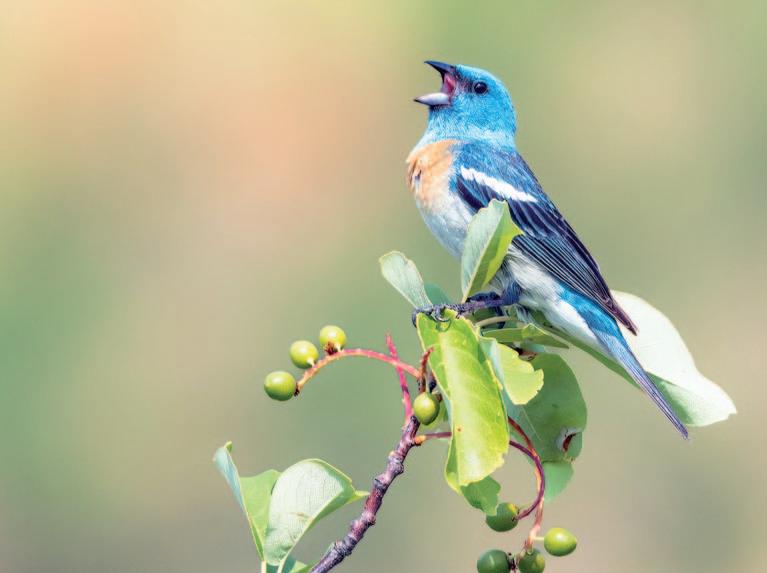
It’s a complicated story, Greene concludes, but by keeping duller males nearby, a super-bright alpha male increases the chances that more females will mate with him. In this case, a particular song doesn’t necessarily improve a male’s chances of attracting females, but it does play a key role in a complex mating game—even if it occasionally frustrates the aspiring birder.
My time with Greene has given me a new appreciation for how the vast vocabulary of birds conveys information. Having created hundreds of thousands of words, we humans are masters of complex communication. But birds too have important things to say—and they’ve developed a surprising number of ways to say it.
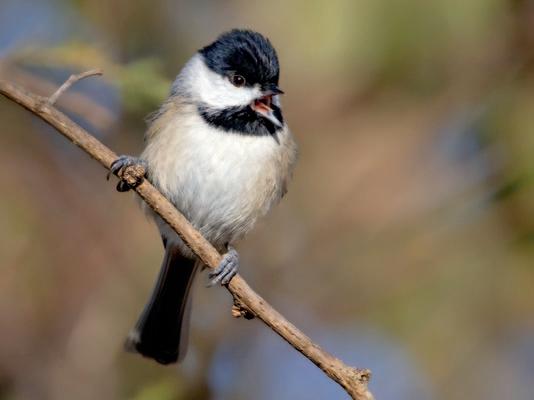
Montana is home to (from top to bottom) lazuli buntings, black-capped chickadees, and redbreasted nuthatches. All three species have distinct calls and songs that even beginners can easily learn from YouTube videos. Knowledge of basic bird vocalizations can provide insight into the dramas that occur all around us as we walk through Montana’s outdoors.
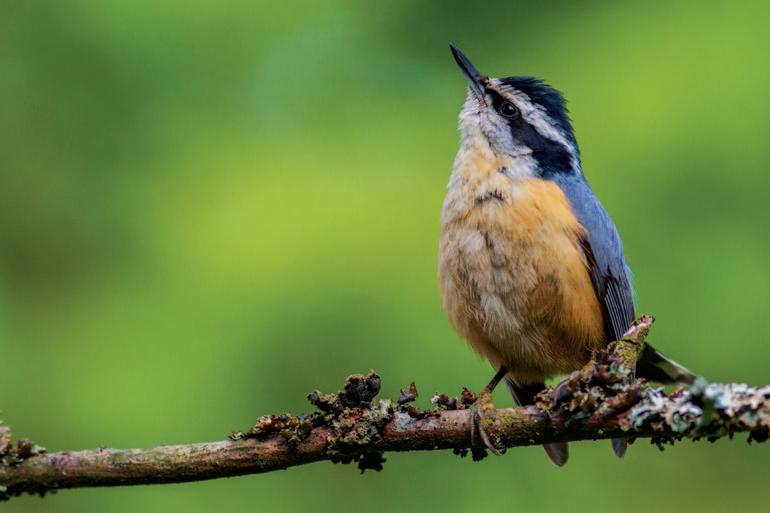
Why do so many of us go all mushy over baby animals, even feeling compelled to pick one up and cuddle it in our arms? Because, deep down, they remind us of human babies.
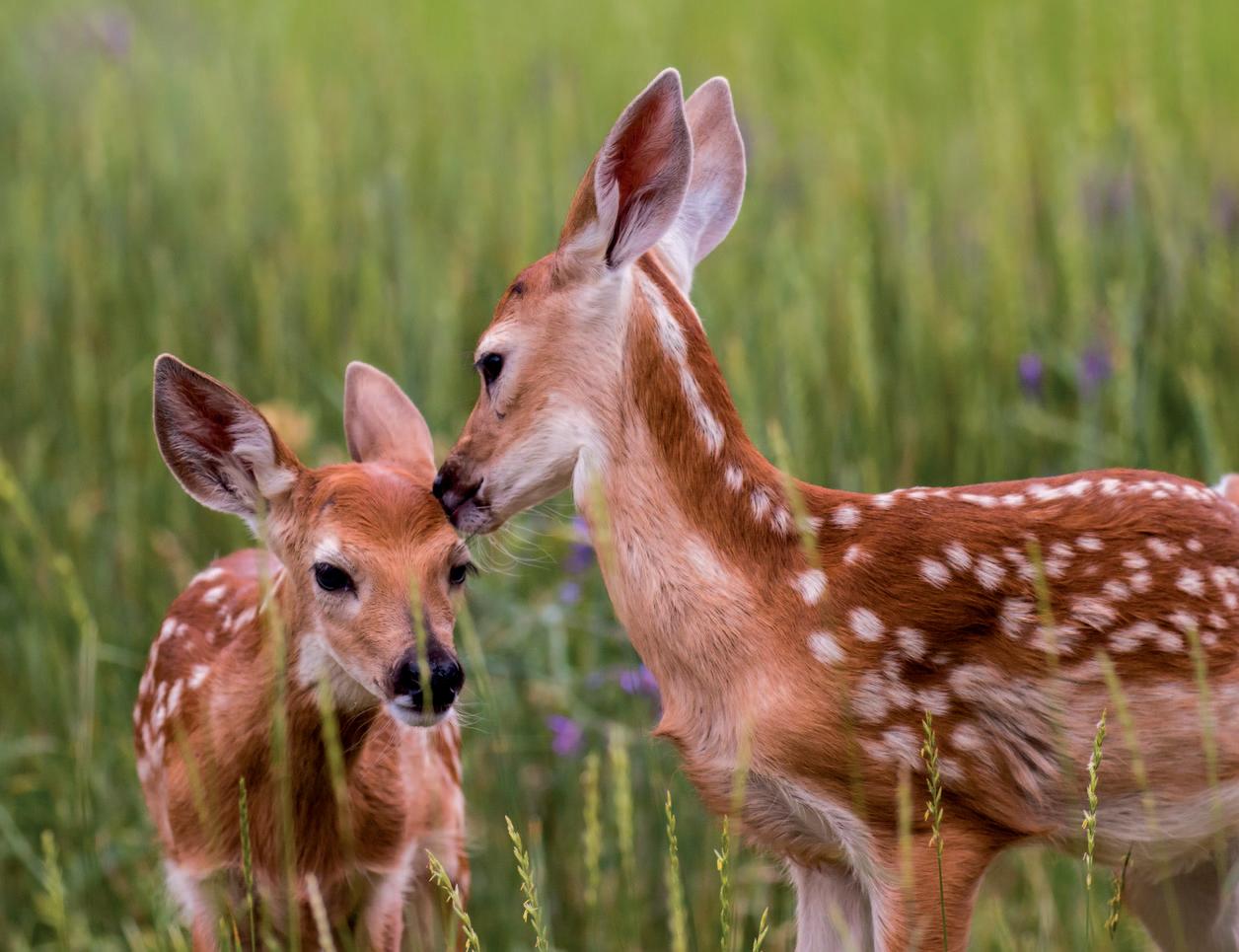 By Jim Pashby
By Jim Pashby
And we go all mushy over human babies because we’re biologically programmed to find them adorable and provide the attention and
Though we do need a few to explain just why baby animals are so adorable.Above: Whitetail fawns near Missoula LAURA VERHAEGHE
protection they need to survive and perpetuate the human species.

Human infants’ proportions—the oversized head, the tiny nose and mouth, and, especially, the massive eyes—are primarily what trigger
our “Awww, so cute” response. In 1943, Austrian ethologist and zoologist Konrad Lorenz described these physiological traits as “baby schema.” Because most baby animals also have these features—even newly hatched rattlesnakes—we are hard-wired

 Above right: Black bear cub LINDA KELLY
Left: Grizzly bear cub STEVE LUFT
Above right: Black bear cub LINDA KELLY
Left: Grizzly bear cub STEVE LUFT
to respond the same way we do toward human babies. Scientists suspect that the powerful human nurturing instinct makes us programmed
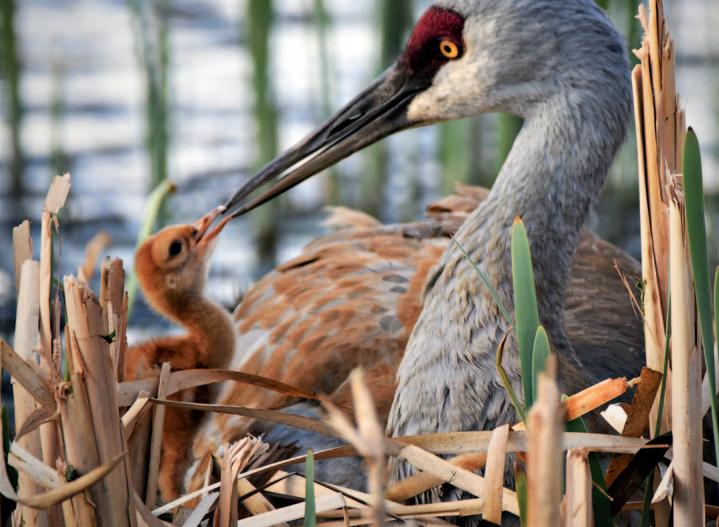

to feel warm fuzzies for anything that vaguely resembles our own offspring. Children, especially, are attracted to baby schema, and manufacturers respond with toys like Hello Kitty and cartoon characters like Disney’s Jim Pashby is a writer in Helena.

Simba, all saucer eyes and balloon heads.
Scientists mapping brain activity have documented how the sight of baby animals triggers human feelings, according to Eloise Stark of the University of Oxford psychiatry department. She
told the BBC, “We know that there is a really fast burst of activity in the orbitofrontal cortex, an area of the brain involved in reward,” she said.
“We think this early activity biases the brain toward processing the cute stimulus—for


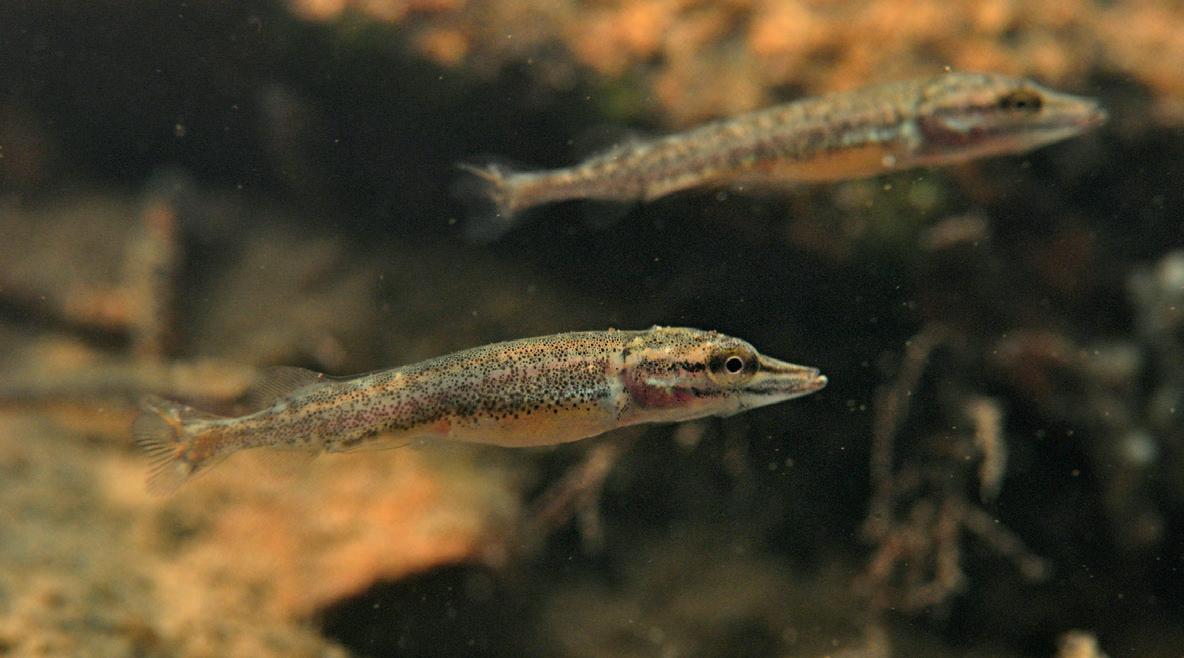
example, by making sure we give it our full attention. The effect of this may be to approach the infant or cute animal, wanting to pick it up or look after it.”
Other scientists have found that an adorable


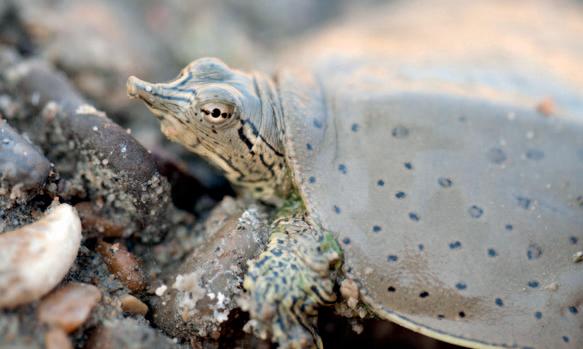
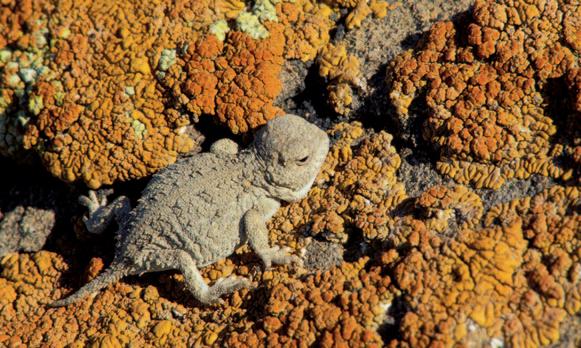
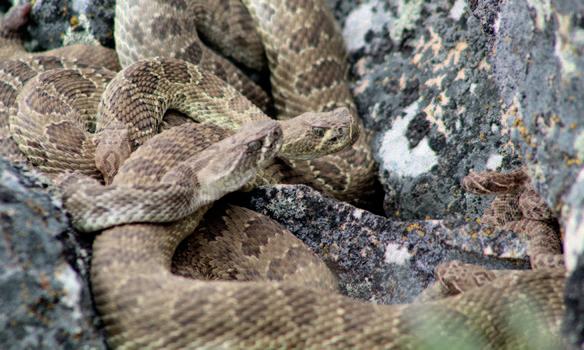
baby human or animal stimulates the part of the brain that releases dopamine, a chemical messenger that helps people feel pleasure. Babylike traits, such as curious or naïve play, giggling, or awkward walking also trigger the

brain’s chemical reward system.
That’s why we melt when watching a moose calf make its first hesitant steps or bear cubs tumble over each other in play. “From the research we have so far, it looks like the cuteness
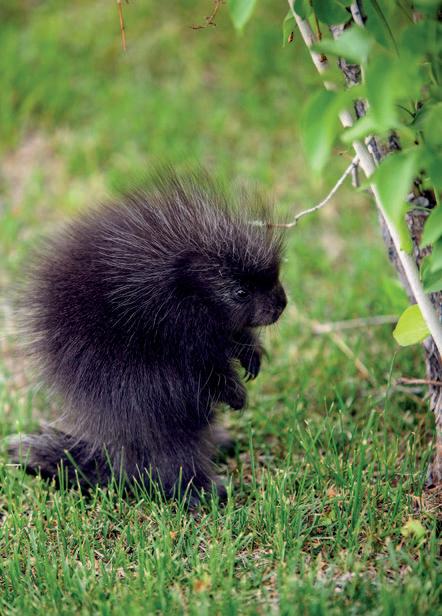

response is inclusive of everyone, regardless of whether you are a parent or not,” Stark told the BBC. “The cuteness activates the same brain mechanisms, regardless of whether the object is a baby, a puppy, or an object.”
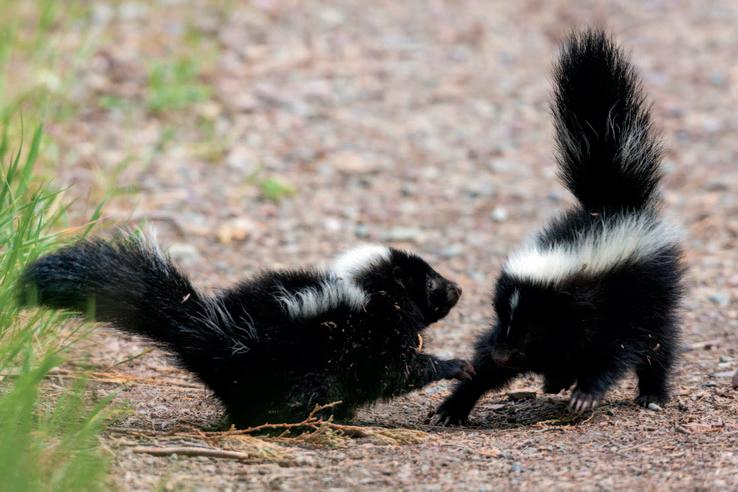

So go ahead and gush, coo, go weak in the knees, and make sad eyes—all those feelings are baked into your DNA. But try to resist the urge to pick up that cute baby whatever. Mom,
likely watching from nearby, might reject her tiny offspring after you touch it, lessening its chances of survival. Your orbitofrontal cortex definitely won’t reward you if that happens.
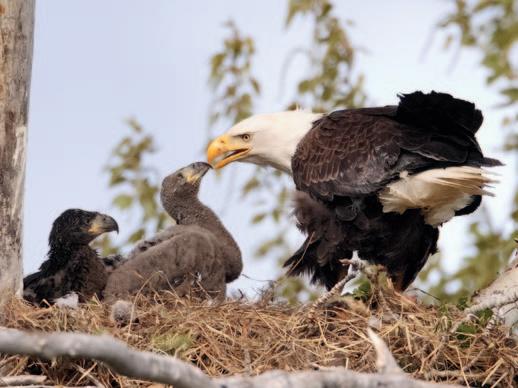
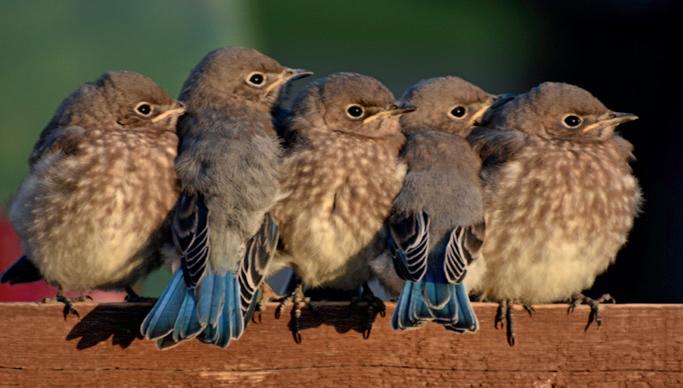

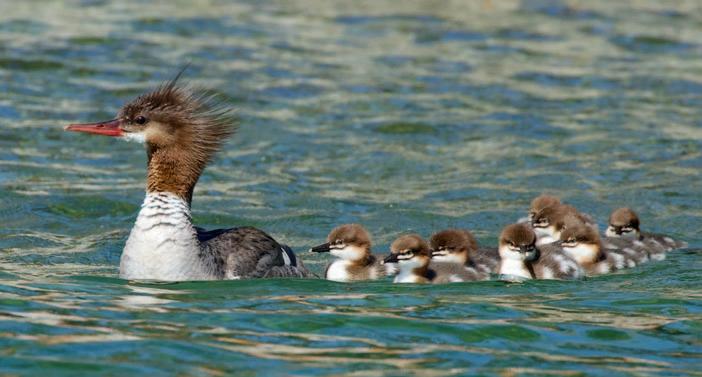


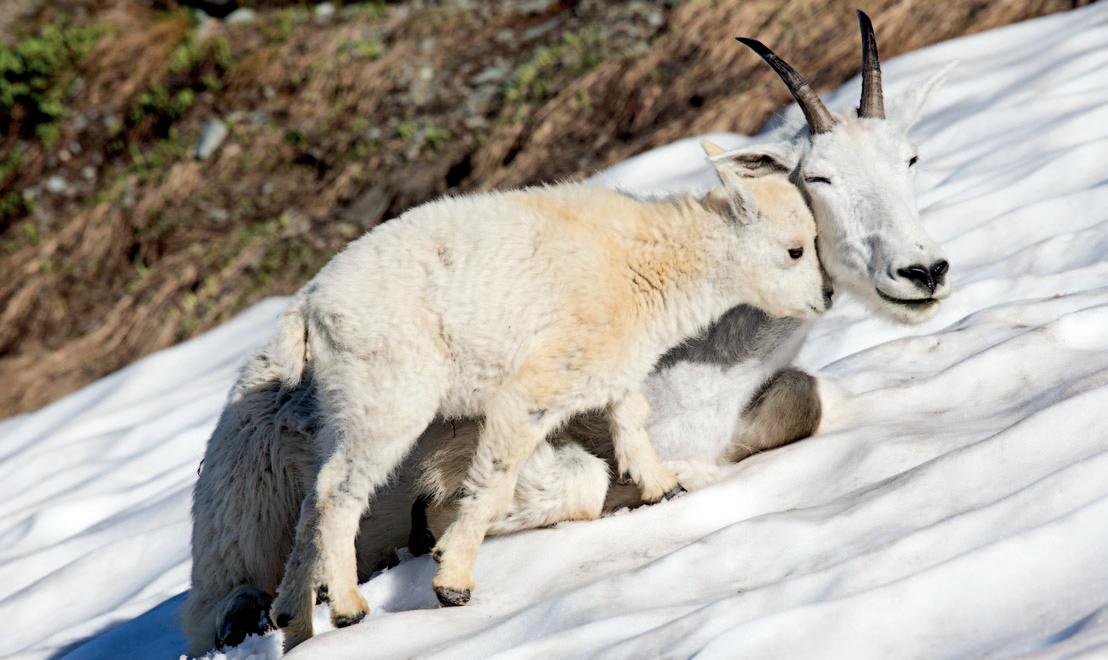
With Mother’s Day just around the corner, I’ve been thinking a lot about a hen mallard that raised her brood on the pond outside my office a few summers ago.

I first noticed her in early June, swimming with nine tiny hatchlings closely behind. The hen’s nest must have been tucked behind a sofa-sized stand of cattails along shore, because the pond is otherwise surrounded by asphalt and mowed grass.
That first day she voraciously gobbled down duckweed as she swam, famished from sitting on the nest 20 to 23 hours a day during the previous four weeks (I learned all this later from online research). The hatchlings stuck close, seemingly stunned to find themselves in water when just a day earlier they’d all been encased in eggshells.
The next day the babies began to enjoy their newfound freedom and swimming skills, venturing away from the hen a few yards. Some even flapped their stubby
“wings.” Mom continued to feed, but after catching sight of me hiding behind a tree, she rapidly swam into the cattails, her brood chirping in alarm as they followed.
Then I noticed: There were only eight ducklings.
Feral cats roam this area. I never spot them during daylight, but in winter I see their tracks, disappearing through holes in the chain-link fence surrounding the property. Also lurking are ravens, crows, and Cooper’s hawks—any of which can kill a tiny duckling.
So it went for the next few weeks. Seven, then six, then five. I worried about the disappearing duck family, especially the harried hen. She was eternally vigilant, swimming about the pond to corral this or that wayward duckling and bring it closer to the group. She never seemed able to relax.
Life is tough for wildlife, especially the moms, who not only have to survive themselves but also protect their vulnerable prog-
eny. A doe, flush with hormones, will chase off a dog, a coyote, or even a wolf to protect her hidden fawn. Female killdeer will fake a broken wing to lure a fox or other predator toward themselves and away from their eggs or chicks. Wildlife biologists tell me it’s common for a mother of any species to risk her own life to protect her young.
I suspect that more than a few human moms reading this are nodding in recognition.
Many years ago, I was having breakfast with my own mom after returning from six months of bumming around southern Africa. I asked her how she could bear to let me go hitchhiking so often, starting back when I was in college. I’d thumbed across the United States, through the United Kingdom and Europe, and most recently from Zimbabwe to Botswana to South Africa.
“Honey, all I can do is hope I raised you to have some common sense, and then cross my fingers that you return home safely,” she replied. “You’re going to go anyway, so I’d rather have it be with my support than without it.”
My wife and I don’t have kids, but I’ve always thought the scariest thing about being a parent must be “letting go”—seeing your child venture into the world, either walking to school on their first day of kindergarten or heading out to explore the Kalahari Desert.
I thought about that while watching the hen mallard and her young. The world can be a dangerous place, far more so for a duckling than a human. But I guess at some point even a mother mallard has to let her little ones go off on their own, hoping she taught them enough skills to survive.
As for the brood I watched that summer, the remaining five ducklings ended up surviving. One late August morning I found that the entire family had all flown off. Whew.
It’s doubtful the hen is still alive. Ducks usually only live a few years at most. She could have been killed by a fox, a hawk, or even a waterfowl hunter like me. But if she is still out there, I’d like to wish her—and all the other moms out there, including my own—a happy Mother’s Day.
During a backpacking trip on Yellowstone National Park’s Two Ocean Plateau, my wife and I stopped at a creek to filter water and spotted a hummingbird feeding on wildflowers. But wait—the “hummingbird” was flying abnormally slow and its bill was too long and bendy, like a miniature bamboo fly rod.
“It’s a hummingbird moth,” said my wife. She might as well have called it the Flathead Lake Monster. I’d never heard of such a thing. Now I’ll never forget it.
Moths and butterflies comprise the order Lepidoptera, or insects with scaly wings. Often maligned as pests, moths provide the same ecological functions and benefits as butterflies, says Marian L. Kirst, with the Montana Moth Project.
Kirst says moths pollinate a wide variety of native plants, helping maintain genetic diversity. As decomposers, they break down dead organic matter and return nutrients to the soil. They also provide food for other insects and omnivorous vertebrates including birds, bats, frogs, rodents, and even bears. Many bird species rear their young on fatty, protein-rich moth caterpillars.
The white-lined sphinx belongs to the Sphingidae family. Members are commonly called “sphinx moths” (for the resting pose of the caterpillar), “hawk moths” (for their swift flight), and even “hummingbird moths” (for their ability to hover while feeding). The caterpillars are sometimes called “hornworms” (for the soft spike on their posterior end).
The white-lined sphinx flies swiftly, beating its 1.5-inch wings around 40 times per sec-
is the
a
ond. The body is brownish tan and the forewings are striped with white lines and a prominent diagonal tan band. Partially pink hindwings are a reminder that moths can be colorful. Characteristic of all moths, its antennae are feathery, unlike slender butterfly antennae, which are tipped by a club.
White-lined sphinx caterpillars are yellow, green, or black and marked by lines or dotted lines of the same colors.
The white-lined sphinx is one of the New World’s most widespread and abundant sphinx moths, ranging throughout Central America north to the contiguous United States and into southern Canada. It prefers open habitats.
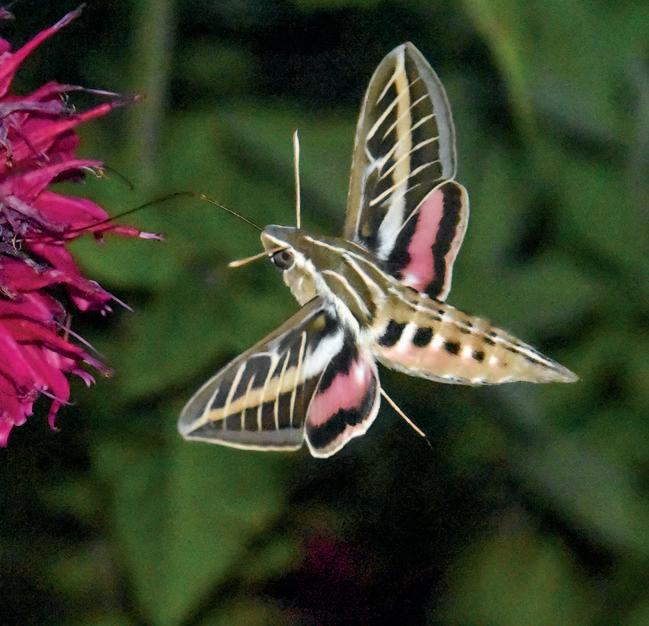
Adult female white-lined sphinx moths lay eggs on various host plants including willow weed, four o’clock, apple, evening primrose, elm, grape, tomato, purslane, and fuchsia. Once hatched, the ravenous caterpillars shed their skin five times until, at full size, they dig a shallow depression in the soil where they pupate. Cued by temperature and moisture levels, the pupae later emerge as adults. A complete life cycle can occur within the spring and summer or require considerably more time if pupae overwinter in the soil.
In Montana, white-lined sphinx moths
a
likely have one or two broods per year, depending on regional conditions and climate, Kirst says. She adds that adult specimens have been collected in Montana as early as April and as late as October.
Adult white-lined sphinx moths are largely crepuscular—active at dawn and dusk. In low light, keen eyesight and a strong sense of smell help adults feed on white and other light-colored flowers. Able to cover many kilometers in flight and travel far ther than many other pollinators, the white-lined sphinx moth’s broad range increases genetic diversity in the plants it pollinates.
White-lined sphinx moth caterpillars feed on many species of the host plants mentioned above. Adult moths feed on flat flowers or unfurl their long, tonguelike proboscis to find nectar in tubular flowers. “In Montana around Billings and in the high deserts of the West and Great Plains, primroses are hugely important to these moths, and you will often see large numbers at dusk and dawn around these flowers,” Kirst says.
Whether it’s by boating, camping, hiking, mountain biking, wildlife watching, or fly fishing the South Fork of the Flathead, Montana is a state where everyone can find their own special way to connect with the natural world. Around here, the outside is in us all. PHOTO BY
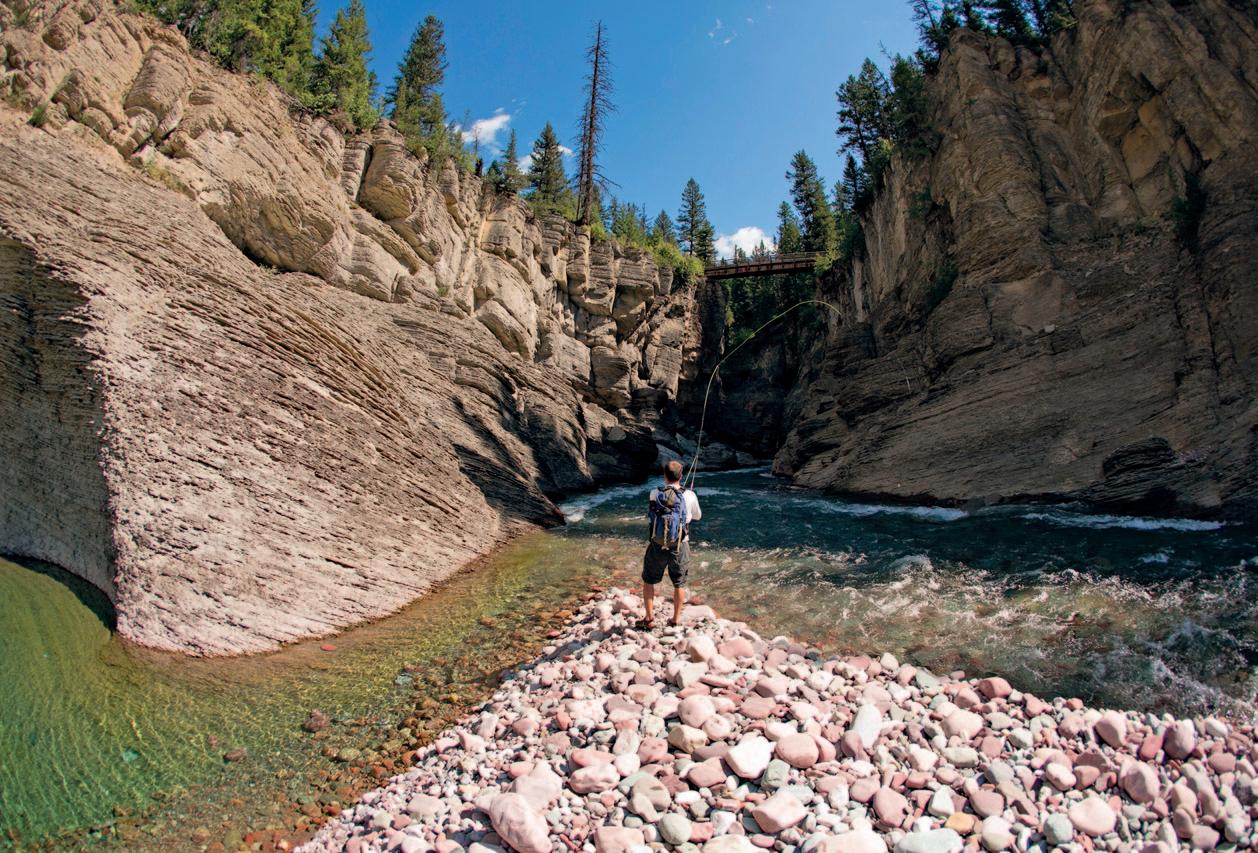
Online: fwp.mt.gov/montana-outdoors
Subscriptions: 800-678-6668

